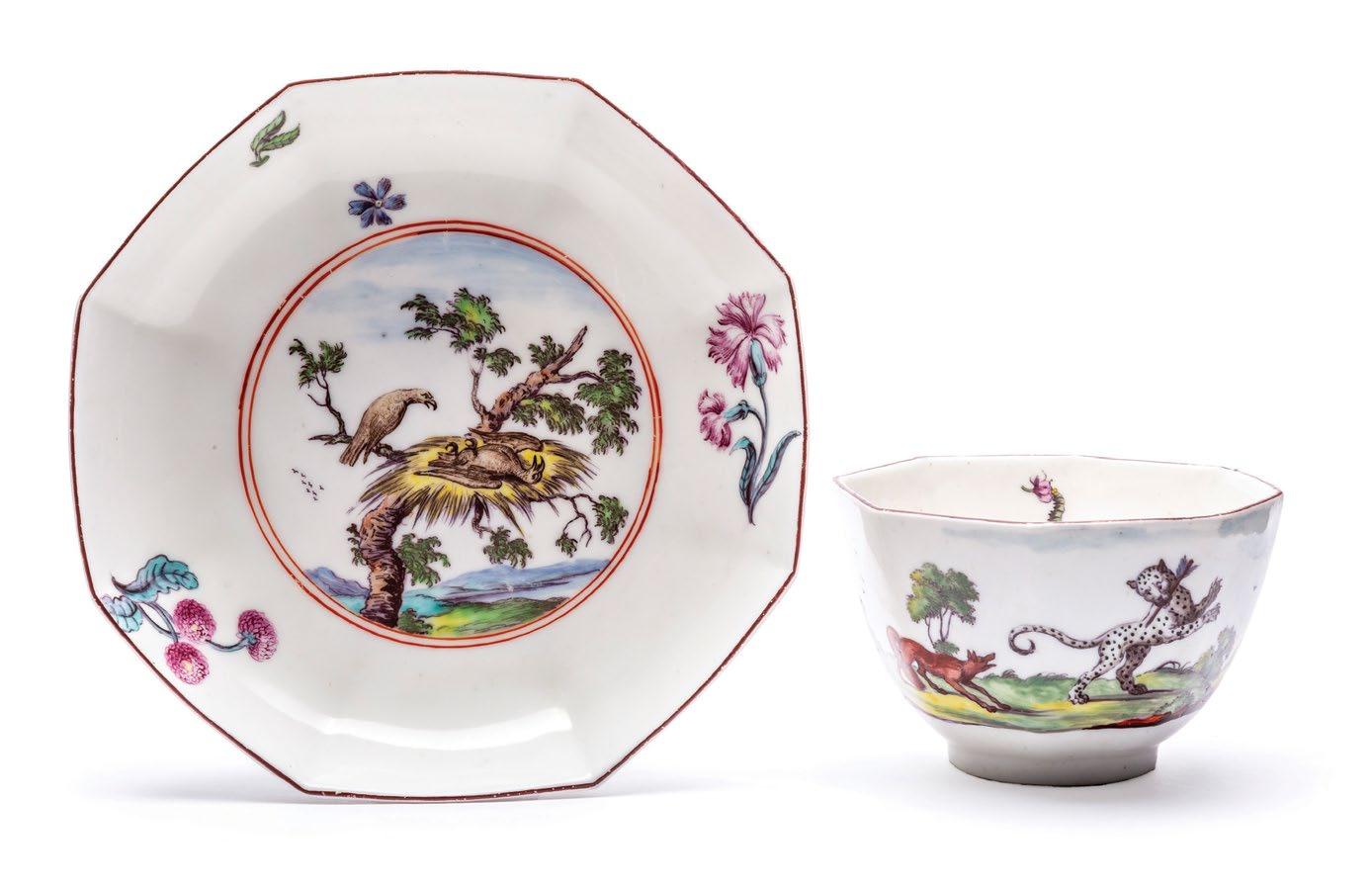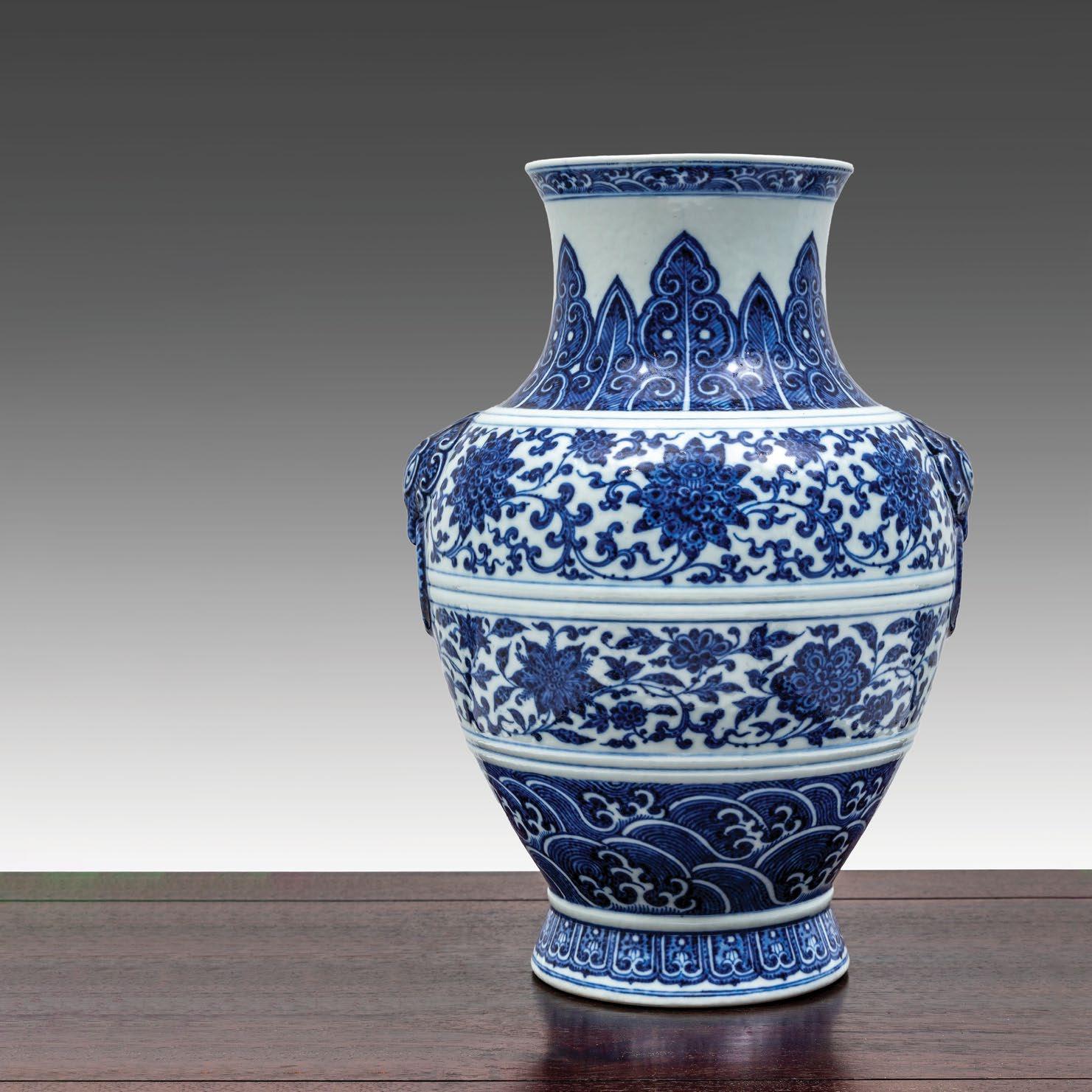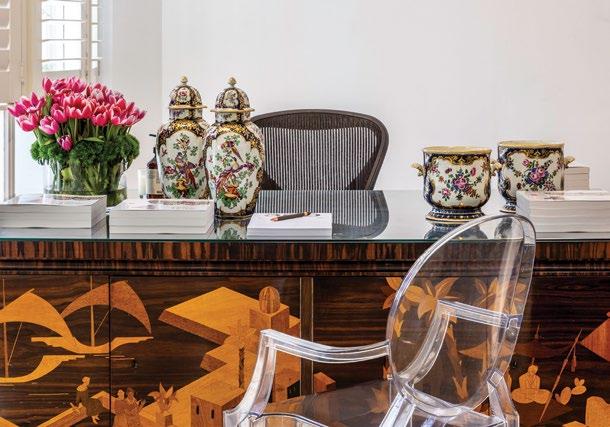How to bid at our Auctions
Catalogues and Viewing
Auction catalogues can be viewed on the Artvisory website www.artvisory.com.au approximately three weeks prior to the published date of an Auction.
Printed catalogues will be available complimentary at the auction viewing and can be express posted (within Australia) prior to the viewing for $20AUD.
The Auction viewing is open to the public and generally takes place during the three days prior to the Auction date, from 11am–5pm at the advertised location/s in the Auction catalogue.
Lot Descriptions
The Lot/Catalogue descriptions provide the overall information of an item including size, date or age, medium, attribution, quantity and if known, provenance.
Estimates
The estimate accompanies each lot in the printed and online catalogue. This estimate takes into consideration the quality, condition, rarity, condition and provenance of the item. Each estimate also has a reserve, and the reserve is the undisclosed and confidential amount set at or below the low estimate. Please note the reserve will never exceed the low estimate at Artvisory.
Condition Reports
Condition reports supplement the lot/catalogue description and focus on the condition of the item. We strongly advise obtaining a condition report if you are unable to view the lot in person. Condition reports and additional images are available to view as part of the auction item listing at Invaluable.com or can be requested from Artvisory directly.
Symbols
Occasionally a symbol is printed next to a lot number in the catalogue, this indicates a special clause that is associated with the sale of that item. Please refer to the Terms and Conditions for specific symbol meanings and information.
Buyers Premium
Artvisory charges a Buyers Premium of 26% plus GST on the hammer price of all Auction items unless otherwise stipulated.
Bidding
Artvisory offers four options for bidding at our Auctions:
Live Bidding
If this is your first-time bidding in person at an Artvisory auction you will be required to register with us, which requires you to fill out a buyer registration form in person at the viewing.
To facilitate this, please bring along your Government issued photo identification, such as a driver’s licence or passport as this is the only form of identification that will be accepted.
Please make sure you register in the name you want your final invoice to be made out to, as invoices once issued cannot be changed, and in certain cases a deposit may be required before you can bid.
Online Bidding
Online bidding via the Invaluable.com platform allows you to bid via the internet in real time, whilst also allowing you to view the live feed of the Auction. You have two options to register for this service:
• Register via the Artvisory website and an Invaluable.com online bidding fee of 2% of the hammer price is added
• Register direct with Invaluable.com and an online bidding fee of 5% of the hammer price is added
Please make sure you register for online bidding at least 24 hours prior to the Auction to ensure you do not miss your lot.
Please note if you have not bid with Artvisory previously, then Government issued photo identification verifying your name and address will be also be required before you can be approved to bid with Artvisory via the Invaluable.com site, and in certain cases a bidding deposit (20% of the low estimate of each Lot you wish to bid on) may be required before you can bid.
Artvisory cannot be held responsible for any errors that occur with internet connectivity during an auction or buyer bidding errors.
Bidding Deposits
Artvisory reserves the right to request a deposit for any buyer wanting to register for the auction, and this must be received in cleared funds 24 hours prior to the commencement of the auction. If the buyer is not successful, then it will be refunded in full by the third day after the auction.
2
Telephone Bidding
Complimentary telephone bidding is available at all of our live Auctions and involves an Artvisory representative calling you approximately 3–5 lots in advance of your nominated lot and you then instruct them to bid on your behalf.
Telephone Bids must be requested at least 24 hours prior to the commencement of the Auction and are provided on a first come, first served basis, as the number of phone lines available are limited.
See our website to download and complete a telephone bidding form and please note that if this is your first time bidding with Artvisory, we will require a clear, scanned copy of Government issued photo identification such as a drivers licence or current passport verifying your name and address and in certain cases a deposit may be required before you can bid. A bidding deposit (20% of the low estimate of each Lot you wish to bid on) may be required before you can bid.
Artvisory reserves the right to request a deposit for any buyer wanting to register for the auction, and this must be received in cleared funds 24 hours prior to the commencement of the auction. If the buyer is not successful, then it will be refunded in full by the third day after the auction.
Absentee Bidding
Absentee bidding offers convenience if you are unable to attend an Auction in person, bid over the telephone, or if you wish to stick to your budget.
An absentee bid should be set at the maximum amount you wish to bid on the lot/s you are interested in purchasing. Should the lot/s be knocked down at an amount lower than the bid recorded on your form, the lot will be sold to you for the lesser hammer price plus Buyers Premium. If identical bids are received for the same lot, then the first bid received by Artvisory will take precedence.
Absentee bids must be received by Artvisory at least 24 hours prior to the Auction commencing and the Company cannot be held responsible for activating any late bids that are received.
See our website to download and complete an absentee bidding form and please note if this is your first time bidding with Artvisory, we will require a clear, scanned copy of Government issued photo identification such as a drivers licence or current passport verifying your name and address and in certain cases a deposit may be required before you can bid.
Payment and Collection
If you are successful with your bid/s, your invoice will be emailed to you immediately after the Auction finishes.
You will pay the hammer price, plus the Buyers Premium of 26% plus GST on each lot, together with any additional charges such as the Invaluable. com online bidding fee, GST on hammer, or the Artist Resale Royalty if applicable.
As per our terms and conditions, payments must be made in full by three (3) days after the Auction has been completed as printed in the catalogue.
We accept Direct Deposit into the Company Trust Account, Eftpos (up to your daily limit) or credit card in person with the following merchant fee applicable (1.43% inc GST for Visa, Mastercard and American Express)
If you wish to pay “over the telephone“ with a credit card you must request a secure payment link by emailing accounts@artvisory.com.au and the secure link will be emailed to you, note the Merchant name on your transaction is KK Partners Group- the Company Trust Account.
Cash payments must be deposited direct to the Company Trust account via any Commonwealth Bank Branch, and goods can be released upon supplying the deposit receipt.
Personal, Company and Bank cheques are not accepted. All payment options and Company Trust Account details are included on the invoice that is emailed to you after the Auction if you are a successful bidder.
All items must be paid for in full and collected within the collection times advertised for each individual Auction. If items are not collected within this time frame then Artvisory reserves the right to charge removal, storage and release fees.
Packing and Delivery
Artvisory has a list of recommended carriers specific to each auction that will be sent to you if you are a successful buyer.
3
CAROL JERREMS
(Australian, 1949-1980)
Judy (Morris) Smoking
vintage silver gelatin photograph, circa 1977 bears Carol Jerrems studio stamp to verso and a later Sun-Herald stamp for 22 July 1984 when it was presumably used for later publication, and with various other ink and pencil inscriptions. Most likely printed by Roger Scott circa 1977 25.3 x 20cm
PROVENANCE
The Sydney Morning Herald Archive Taken on set of the film: 'In search of Anna' 1977.
$8,000–12,000
Carol Jerrems was the still photographer for the 1978 Australian film In Search of Anna, which was directed by Jerrems’ then boyfriend, Esben Storm (1950–2011). Ref: King, Up close: Carol Jerrems, 2010.
The movie starred Judy Morris as Sam. Esben Storm said of the movie: 'I became aware that all the films being made in Australia were period films, Picnic at Hanging Rock, The Getting of Wisdom, Between Wars. I felt this reflected a society that was unable to come to terms with where it was at. I know you have to look into the past and find your heroes but it seemed to me that it was reflective of a desire not to face up to where we were at. That also coincided with where I was at personally in my relationship to women and to Haydn [former collaborator Haydn Keenan] so I thought I should make a film about leaving the past behind and coming to terms
"There is no nostalgia in her pictures, but rather, a passionate identification and total engagement with the present"
Helen Ennis
"I really like people. I’m not into landscape, that just makes me feel cold. I try to reveal something about people, because they are so separate, so isolated..."
Carol Jerrems 1974
with the present, moving into the future with a positive attitude. That's what I thought I should do personally and that's what I felt Australia should do. It led to In Search of Anna' Film maker and artist Paul Cox, who was an important influence on Jerrems, comments in his introduction to the Australian National Gallery touring exhibition – Living in the 1970’s: ‘Carol was honest’ ‘Every image carries her heart and soul and thus becomes a self-portrait’
Helen Ennis who curated this exhibition says: ‘In 1976 Jerrem’s output in photography began to shrink and by 1979 was only a trickle. I think there were a number of reasons for the apparent waning of her interest in photography. The first was her increased involvement with film’ ‘In 1975 Jerrems was awarded an experimental film grant from the creative development branch of the Australian Film Commission’
In 1977 and 28 years old, Jerrems produced the production stills and publicity for Esben Storms film ‘In Search of Anna’ This image was taken as part of that commission. On viewing this photograph, you really sense the photographer in it and so is it actually the films character Sam smoking, or Judy (Morris) smoking, or is it perhaps Carol (Jerrems) smoking.... There is a melancholy in the languid expression of the face and the eyes look directly outward, but they are not really connecting with you. There is also a rebellious, perhaps feminist, bravado in the way the lit cigarette balances on the closed and perfectly formed lips and a waft of silk-like smoke drifts up and away from the face. Vale street, taken two years earlier in 1975 is Jerrems’ most famous photograph (Sold by Deutscher and Hackett 22/11/2023 lot 43 for a current artists auction record of $171,818 ) Judy Smoking must surely rank amongst her most captivating and brilliant photographs. It is a once-seen never-forgotten image.
1
4
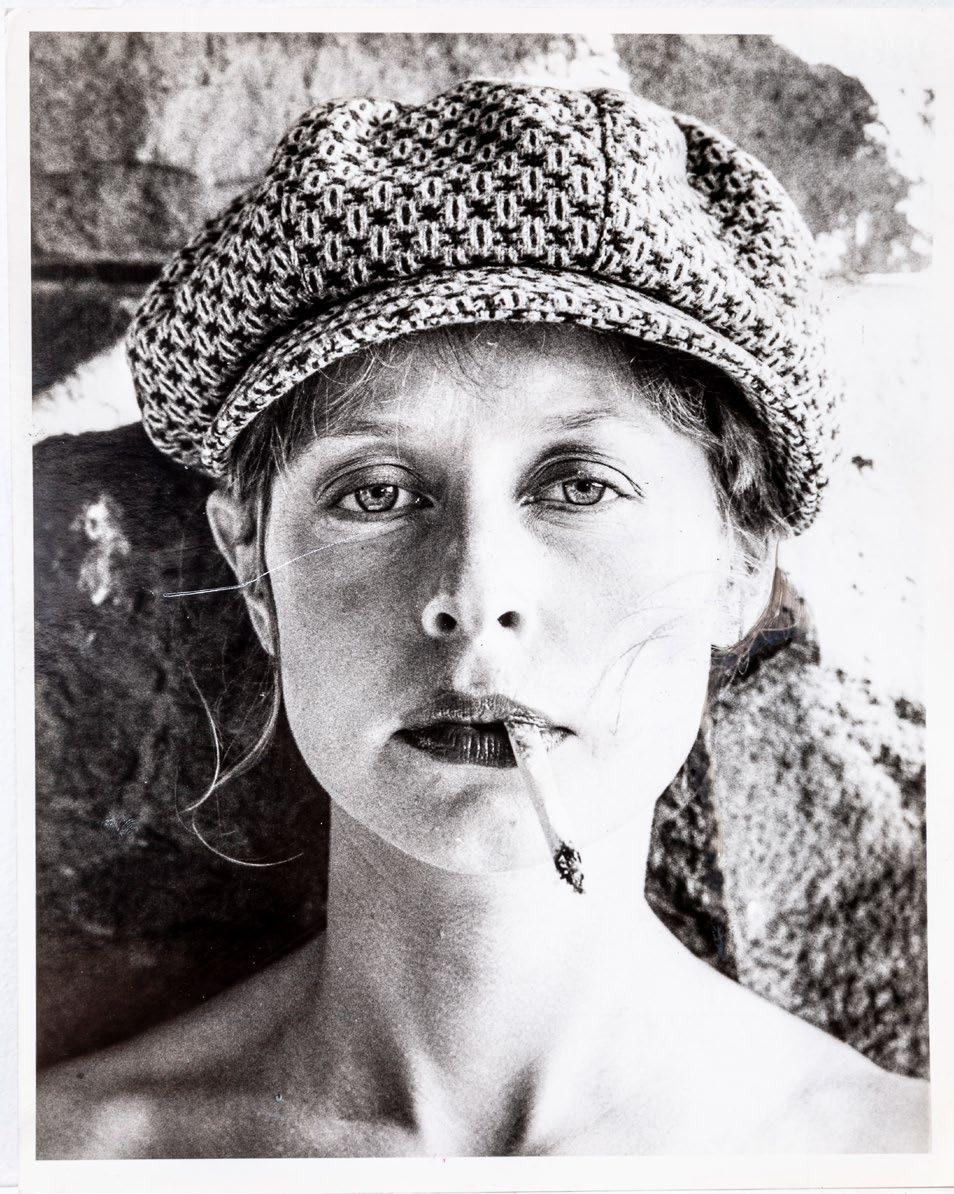
1 5
JUSTIN O’BRIEN (Australian, 1917-1996)
Portrait of a man oil on canvas signed O’Brien lower right with an unfinished study of a woman to the reverse 61 x 50cm
PROVENANCE
By repute acquired by a Mr M.Levy in Rome circa 1970’s, and thence to his Paris home in Rue Villlier, until his passing in 2015.
Acquired in Paris as part of the purchase of the apartment by Mr Henri Perez The current vendor assisted with the subsequent sale of many artworks and furnishings from this apartment from Mr Perez and acquired this work as part of those arrangements.
$12,000–18,000
Maurice Justin O’Brien (1917-1996) was born on 2 August 1917 at Hurstville, New South Wales, and enjoyed a serene childhood on his family’s semi-rural property.
O’Brien realised at the age of six that he wanted to be a painter when, during a stay with relatives at Elizabeth Bay, he was given a set of coloured chalks, pencils, and drawing books.
Volunteering for service in World War II, O’Brien enlisted in the Australian Imperial Force on 31 May 1940 and was posted to the 2/5th Australian General Hospital (AGH) as a nursing orderly. The unit arrived in the Middle East in November and relocated to Ekali, Greece, in April 1941. As the German army advanced, he was among the 165 personnel who remained to care for casualties and were taken as prisoners. For several months, the hospital continued to operate under German control. By January 1942 he was moved by cargo ship and cattle trucks to Stalag XXA, a prisoner-ofwar camp at Toruń, Poland.
While detained, O’Brien developed friendships with other painters. He joined the camp’s theatre group, facilitated art classes, and painted, relying on voluntary aid organisations to provide art supplies. In October 1943, he was taken to Barcelona, Spain, for repatriation following a prisoner exchange. He returned to Sydney in January 1944.
Artworks that he had completed while in captivity formed the core of a joint exhibition held in Sydney at the Macquarie Galleries in March 1944, the show was believed to be the first exhibition of returned servicemen’s art to be held in Australia.
On 27 July 1945 O’Brien was discharged from the army. Later that year he was appointed art master at Cranbrook School, Bellevue Hill. When not teaching, he continued painting, exhibiting, and undertaking commissions, and joined the Sydney Group of modernist painters. By 1946 he was living at Merioola, a Victorian mansion at Woollahra that was run as a boarding house for bohemians. O’Brien considered this period one of the happiest and most formative of his life; he lived alongside and met other artists, several of whom became lifelong friends. The next year he held his first solo exhibition at the David Jones Art Gallery under the direction of Marion Hall Best.
In 1948 O’Brien took a two-year sabbatical from Cranbrook and proceeded overseas. He rented a flat in London and travelled in Spain, France, and Italy. At a solo exhibition at London’s Hanover Gallery in July 1949, his works were praised for their ‘glory in brilliant colours’ Back in Sydney, he won the inaugural (1951) Blake prize for religious art with the triptych The Virgin Enthroned, later bought by the Felton Bequest trustees for the National Gallery of Victoria.
At the end of 1963 O’Brien again left Cranbrook to travel to Europe, including four months on the Greek island of Skyros with the artists Jeffrey Smart and Brian Dunlop. The trio leased a fisherman’s cottage and worked on landscapes, still life’s, and portraits. He returned to Australia in mid-1965.
At the end of 1966 O’Brien resigned from Cranbrook to dedicate his time to painting. After another prolific stay on Skyros, he moved to Rome. In early 1968 he was commissioned to create a mosaic to represent the southern hemisphere for the Basilica of the Annunciation at Nazareth and asked his Roman friend and pupil Egidio Scardamaglia to pose for the angel.
By then, O’Brien had decided to relocate to Italy permanently. There Scardamaglia, his wife, and their two daughters would become his adoptive family.
In researching this painting we have been in touch with Egidio Scardamaglia in Italy and with Christine France who wrote the book on Justin O’Brien and we have not been able to identify the sitter of this portrait, nor have we have been able to narrow this work down to an exact period. However, we know that when O’Brien was taken prisoner in Greece in 1941, he painted a number of portraits. The signature is in line with the way he signed his works at this very early and formative period of his work. At this time O’Brien’s experimental painting style was much looser and more impressionistic to what it would later become post-war.
Egidio Scardamaglia remembers O’Brien telling him that when O’Brien was exchanged with some German prisoners (in 1942) he took with him some portraits, rolled up under his arm. In "Justin O'Brien – The sacred Music of Colour" by Barry Pearce and Natalie Wilson p. 32 they refer to this period: “Ironically, his forced confinement gave him plenty of time to paint. Through the Red Cross and the YMCA he was supplied with pencils, oil paint and paper... Models were plentiful and varied. One of his earliest surviving works from Torun is of a French prisoner, Charles Mahieu, with whom he became great friends (p. 32) Mahieu was also a competent artist and when they left the camp O'Brien presented him with his portrait: "A Frenchman with a very long nose...and a beard, and he was wearing one of those marvellous blue coats they had in the French army.
At Torùn, O'Brien discovered the allure of the French Post-Impressionists and his paintings exploded with colour, as in Man with the beard c.1943 (p. 31), Man with the yellow shirt c.1943 (p. 34) and A Spaniard 1943 (p. 35) these are boldly executed portraits in which the catalytic influence of Van Gogh and Cézanne is clearly visible: acrid greens and sulphurous yellows, with flashes of mercurial red, dominate.
2
6
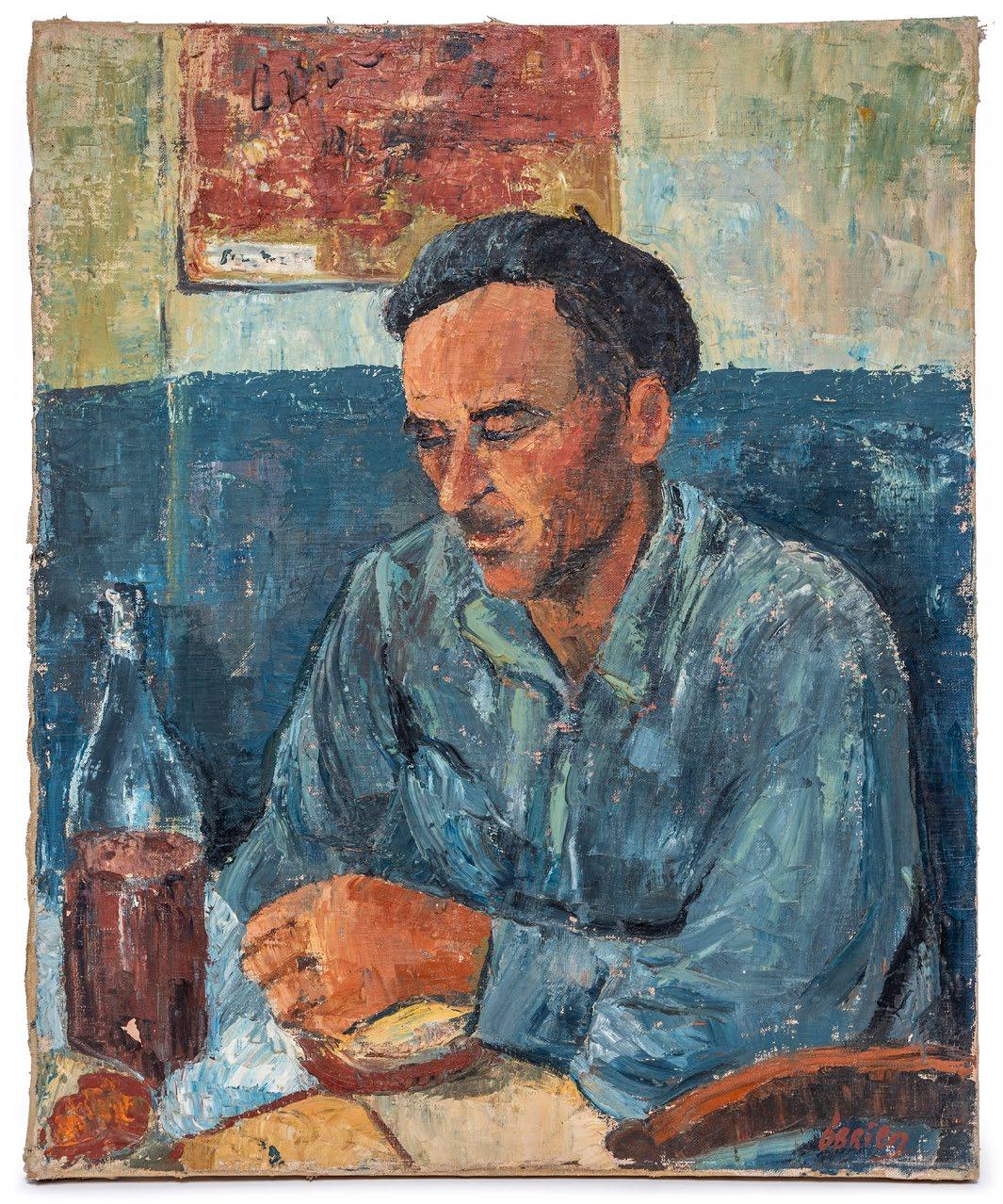
2 7

3
LEONARD FRENCH
(Australian, 1928-2017)
Nicholas Copernicus, 1543
enamel with gold leaf on hessian covered hardboard and sheet copper signed lower right 181 x 151cm
PROVENANCE
A Distinguished Melbourne family collection
$40,000–60,000
Leonard French OBE (1928–2017), who created the great stained-glass ceiling at the National Gallery of Victoria, was widely regarded as one of the leading Australian artists of his day. By the early 1970s this outgoing working-class boy from rough and tough inner-Melbourne Brunswick had become top of the artistic heap, cock of the walk: his monumental glass commissions, murals and paintings were critically acclaimed and his commercial success was firmly established. A feisty contrarian with an eloquence that belied his humble origins, he delighted in publicly roasting the Australian art establishment. Sasha Grishin in his book on Leonard French talked of his early influences and in particular that of Fernand Leger, whose work French had seen in the 1940's. Grishin comments that in 1950 in London French visited the Leger retrospective exhibition at the Tate and that he immediately identified with the son of a
cattleman from Normandy that wanted to bring art to the people through murals and via accessible public art. Despite his humble background French had a keen appetite for literature which ranges from the classics to poetry and through his artistic associations at the Swanston Hotel in Melbourne he was exposed to the raging left-wing intelligentsia of the time, where T.S Eliot, Albert Camus and Dostoevsky were the staples that were much discussed.
Through his travels to Ireland and Europe he was exposed to ancient cultures such as Celtic and Ancient European and Mediterranean art, which had a great influence on him and his work. French would go on and become a leading light within the star-studded artist stable of legendary Australian art dealer Rudy Komon in Sydney and would win the much revered Blake Prize twice in 1963 and 1980 and The Sulman at the AGNSW in 1960. The application of sheet copper is seen in several of French's important works from the 1960's, such as: The Cannon and The Wind 1966-70 See Sasha Grishin Leonard French colour plates 115/119. However, French exhibited a body of work called the Copernicus series with Rudy Komon in 1973 and this work may well have been included in that exhibition.
Nicolaus Copernicus the great Renaissance mathematician, administrator, astronomer and physician died aged 70 in 1543. Amongst his many extraordinary achievements, perhaps the greatest was in formulating what became known as the Copernican system, a model of the universe that placed the Sun rather than Earth at its center.
8

© Leonard French/Copyright Agency, 2024 3 9
RALPH BALSON
(Australian, 1890-1964)
Constructive Painting, 1946 oil on board
signed R Balson and dated 46 lower left 91.3cm high, 106cm wide
PROVENANCE
Acquired by Sir Raymond Burrell, of Forglen and later Rosemount, Woollahra, Sydney, from Gallery A Sydney on the advice of Chandler Coventry Sydney.
Bears Gallery A Sydney exhibition label to verso, Cat. No 15. Inscribed in pen: Owner Raymond Burrell Forglen Armidale NSW
$300,000–400,000
Ralph Balson is credited with holding the first solo exhibition of purely abstract work in Australia, but his beginnings were very humble, as an apprentice plumber and house-painter in Dorset, England and he did not begin painting until his early thirties following his arrival in Australia in 1913.
Becoming central to a group of modernist artists in Sydney from the early 1930s, Balson was exceptional in his development towards an entirely non-objective form of painting. Balson was a pupil of Grace Crowley at art-school and they formed a strong artists relationship. Balson later inspired his former teacher to experiment further with abstraction, although as his close association with Crowley went on, his career reaped the greater benefit from their association and increasingly Crowley would defer to Balson, as the greater artist in her view. Balson was excited by the geometric constructive approach advocated by French Cubists André Lhote and Albert Gleizes. When Crowley and Rah Fizelle established the Crowley-Fizelle School in George Street, Sydney, in 1932, Balson assisted by painting the premises.
From 1934 to 1937 he painted in the studio of the school, exploring geometric Cubist principles of composition. Here he met Eleonore Lange and Frank Hinder, who introduced him to the works of Kandinsky, Léger, and Mondrian who had a fundamental influence on his work.
In 1939 Balson participated in Exhibition I, a group show of modernist painting and sculpture with works by Crowley, Fizelle, Lange, Hinder and his wife Margel, Gerald Lewers and Frank Medworth, but they met with an unreceptive Sydney artworld of the 1930’s and 1940’s. Undeterred by this response, Balson continued to develop his hard-edge and heavily abstracted works and in 1941 he exhibited these works in a formative solo exhibition at the Anthony Hordern Gallery. His paintings were flat geometric abstractions employing overlapping planes of colour, which the artist referred to as ‘constructive paintings’, such as Construction in green 1942, (Collection of AGNSW) completed the following year.
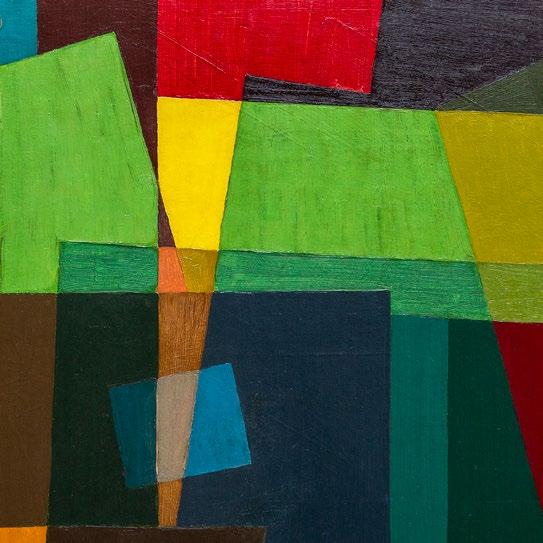
The most accomplished works he created were painted in the 1940’s and 1950’s before he changed his style completely, in line with the avant-garde of the time, to what are now called his matter paintings. Balson's construction works from the early 1940's feature circles and curvilinear forms, but by the mid-1940's Balson had moved towards more rectangular and squared forms and then as a further progression from these works, to semi-transparent and overlapping hard-edge abstract images with a two dimensional quality, where you cannot really tell where the surface or bottom of the image might be.
Australian Art Curator Beckett Rozentals curated the current exhibition at the National Gallery of Victoria: Grace Crowley and Ralph Balson. During one of her lectures coinciding with the exhibition, she talked about the signatures of Balson’s paintings where it would appear that Grace Crowley executed the signatures on some of Balson's works from the 1940’s and 1950's and this is evident by a much more fluid script, with a cross line and vertical bar before the date. The more simplistic signatures on a few of Balson’s works from the 1940s would appear to be in his own hand, as is the case with this work.
This outstanding work from 1946 shows Balson at his brilliant best, both as a picture-maker, but also as a colourist par excellence. When you inspect this work close-up it is hard to believe that he could have painted this free-hand, as he did, and without the use of stencils or such-like. There is an exceptional luminosity and silk-like quality to this painting and it is an image of incredible beauty that, remarkably, was created just one year after the finality of what was a very horrible chapter in world social history.
4
10

4 11
ARTHUR BOYD
(Australian, 1920-1999)
Rockface – (Shoalhaven)
oil on canvas
signed lower right 106 x 182cm
PROVENANCE
Acquired by the vendors family from the original exhibition at Australian Galleries, Derby Street, Collingwood, Melbourne.
ESTIMATE ON REQUEST
Arthur Boyd returned to Australia in 1971, eager to rediscover his antipodean roots, having spent over a decade in the lush English countryside. A short time after his homecoming, art dealer Frank McDonald invited Arthur and his wife Yvonne to visit his property by the banks of the Shoalhaven River, on the south coast of New South Wales. On this sweltering hot day Boyd commenced a sketch of the Shoalhaven River, thus beginning a love affair with the region and its many moods. Boyd and his wife Yvonne purchased two properties in the Shoalhaven region, Riversdale and Bundanon. Each provided access to stretches of the meandering Shoalhaven River and magnificent Pulpit Rock. From their living room, the Boyd's experienced the constantly changing light which turned the sky from the darkest blacks to the brightest blues, with mauves and indigos in between.
As Barry Pearce writes, ‘They experienced Australia’s seasons and catastrophes; in high summer the air so clear and hot that light carved out the shapes of rocks like a burning scalpel. When the floods came after endless days of rain, the river heaving its great brown mass towards the sea, carrying it all before it.’
Earlier in his career, Brueghel and Rembrandt had offered inspiration; now Roberts, von Guérard and Buvelot came to be Boyd’s artistic forebears. This period saw Boyd re-establish his roots in the country of his birth and embark upon a powerful series of paintings which are not simply landscapes but a fusion of his rich European and Australian heritage, infused with social, mythological and personal significance. As Boyd observes: "The variation of this area with its great deep tones and high keys has an analogy with music. In the desert there is only one note, just one long singing note. In this landscape the tonal range – not tonal in the obvious sense of colour, but the actual fact of the horizon, which vary from very high to low to infinite, depending on your line of vision – makes it a greater challenge. It has a knife-edge clarity. Impressionism could never have been born here, but Wagner could have composed here. He could not have composed at Port Phillip Bay"
In many of Boyd’s Shoalhaven works, the artist divides the picture plane into two halves thus paying direct homage to the compositions of the Heidelberg School and most notably, Tom Roberts, whose horizons punctuated with eucalypts have become iconic images within Australian art.
The majesty of the soaring cliffs which border the Shoalhaven remained a perennial image of the Shoalhaven series, with the sunbathed Nowra sandstone standing timelessly above the tranquil river. As Janet McKenzie has observed; 'The natural beauty of the Shoalhaven area caused Boyd to marvel constantly. His paintings are a celebration of the grandeur and wonder of Nature. It is to Boyd's credit that a single landscape can inspire such diversity of work. He gives us the impression that in life there are infinite possibilities, as long as we train ourselves to see. Devoid of the boats, figures and swans, often featured in the series, Shoalhaven is a pure landscape, celebrating the unspoiled bush, completely removed from urban life. The piercing blue of the sky above the still waters of the river, creates a scene that ‘glows with well-being, joy and a sense of youth’. Shoalhaven is removed from the religious and lyrical connotations imbued in a number of paintings of this subject, instead portraying a truly enchanting summer day, with ‘air so clear and hot that light carved out the shapes of rocks like a burning scalpel.’
Sandra McGrath describes Boyd's influences: "While Boyd in general chooses to portray the Shoalhaven landscape more identified with Von Guerard and Buvelot, at other times he cannot resist the temptation to paint the landscape in the manner of the early Box Hill painters ... Despite their reliance on a realistic approach to the subject, the Boyd Shoalhaven landscapes are more varied in technique and style than one might suppose. With his prodigious ability the artist is able to take the nature of the subject and render it in a manner which captures the essence of its particular properties at that time, or imbue it with a sense of character and meaning which is the result of his own immediate emotional or psychological response. Having always delighted in his painting trips along the river, Boyd believed his magical Bundanon property should belong to the Australian people. Soon after Shoalhaven was painted, the property was gifted to the Australian Government, to be preserved forever, in the hope that future generations may also be inspired by the beauty and brilliance of the Shoalhaven River.
McKenzie, J., Arthur Boyd at Bundanon, Academy Press, London, 1994, p. 42
McGrath, S., The Artist and the River: Arthur Boyd and the Shoalhaven, Bay Books, Sydney, 1982, p. 62/63
Pearce, B., Arthur Boyd Retrospective, The Beagle Press, Sydney, 1999, p.27
5
12

© Arthur Boyd/Copyright Agency, 2024
The current auction record for a Shoalhaven work stands at $834,545 inc BP: On the Banks of the Shoalhaven, 1984, 152 x 122cm, set at Smith & Singer, Important Australian Art, Sydney, 02/05/2023, Lot No. 8. (Illustrated first right)
The second highest being $613,636 inc BP paid for Shoalhaven Riverbanks and Large Stones, 1981, oil on canvas, 152.5 x 123cm, at Deutscher and Hackett, 100 Highlights from the Cbus Collection of Australian Art, Melbourne, 27/07/2022, Lot No. 38. (Illustrated second right)

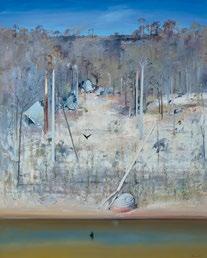
5 13

of shapes available in junk metals, he began to create rigorously abstract yet metaphorically ‘alive’ assemblages of spiky and bristling forms from mundane materials such as typewriter parts, sending 19 back to Sydney for an exhibition at the Clune Gallery.
The success of the exhibition prompted Klippel’s return to Sydney in 1963 where he continued to work with junk machine parts unmoved by the advent of minimal and conceptual trends in sculpture. Experimenting with bronze in the late 1960s led to greater scale and simplicity in his work, and he began to employ wood, plastic and metal to create both monumental and miniature sculptures. The linking theme of work of this era was ‘sculpture-in-the-landscape’, which referenced both human scale and nature, revealed in his No 202 Metal Construction 1966 in which welded steel and found objects are synthesised into a resolved sculptural form that hovers between the organic and the mechanical.
For the last three decades of his life, Klippel worked out of separate studio-rooms in his harbour-side home in the suburb of Birchgrove, engaging in the different activities of drawing, collage, welding, woodwork, clay modelling and plastic assemblage that responded to the creative principles he had established decades earlier.
His last significant series, including massive assemblages such as No 714 Wooden prototype for Adelaide Plaza bronze 1988, utilised discarded wooden patterns for machine parts discovered in an industrial foundry in Ultimo.
14

6 15
© Andrew Klippel. Courtesy of The Robert Klippel Estate, represented by Annette Larkin Fine Art, Sydney and Galerie Gmurzynska, Zurich/Copyright Agency, 2024
A magnificent and historic sterling-silver presentation cup and cover, London, 1857
78cm high, approximately 44cm wide
Makers mark for George Adams, Retailers mark for Kilpatrick and Co London and Melbourne Inscription reads: Presented to The Honourable Mr Stephen George Henty Esquire, Member of the Legislative Council of Victoria by His Numerous Friends Resident in the Town and District of Portland as recognition by them of his worth, and as a mark of the esteem and regard in which he is held, by all Classes of the Community and which he has earned from himself during a long and prosperous career from the earliest Settlement of this Colony on 11 May 1859
Total weight 7.65kg
$80,000–120,000
Together with the accompanying testimonial on vellum that reads: To the Honorable Stephen George Henty Esq MLC, in pencil Presented at Mac's Hotel Portland on May 11th 1859. We have great pleasure in having the opportunity of presenting you with this small token of the high esteem in which you are held by your friends in the Western District.
We regret that the short notice of your intended visit to Portland precludes the presence of these subscribers resident in the country but we are assured that a similarity of sentiment on this occasion pervades all and that they with us now present feel equally proud to have the opportunity of testifying in this presentation their appreciation of your long residence and honourable services amongst them as a Magistrate a Merchant a Citizen and a Friend.
We will not attempt to particularise the various services which you have endeared yourself to this community as no one is held in higher estimation and we regret that the circumstances have caused the removal of yourself and family from amongst us. Its one of our Representatives in the Upper chamber of the Legislative. We trust you will still watch over out interests and continue to feel that sympathy with us which has hitherto characterised your public career. Accept then Dear Sir this pledge of our kindly feelings towards you and yours and that the Almighty may continue to protect you and prosper you in all your undertakings is the sincere wish of the subscribers to this testimonial. We have the honour to remain yours very sincerely. Then signed by some 105 names of eminent early settlers (See additional photos online to read these names).
Stephen George Henty (3 November 1811 – 18 December 1872) was a farmer and politician in colonial Victoria, a member of the Victorian Legislative Council. Henty was born in West Tarring, Sussex, England, the son of Thomas Henty (1775–1839) and Frances Elizabeth, née Hopkins. Henty arrived at the Swan River settlement with brothers James and John in 1829. In 1836 Stephen settled in Portland.
In 1839, Henty led an overland expedition to explore the Mount Gambier region. He was the first white man to climb the peak and view the blue crater lake.

In 1842, Henty and his brother Edward laid claim to the land around Mount Gambier and established a sheep station there. Conflict with the local Aboriginal residents quickly ensued that same year and the situation proved too hard for Stephen Henty, and he abandoned the Mount Gambier property later in 1844 with significant loss of capital.
Edward Henty, Victoria's first settler, is popularly regarded as the chief actor in the early history of Portland Bay; but the backbone of the growing town and the first to set up stations inland was undoubtedly Stephen Henty. Arriving at Swan River in 1829 with James and John, after an attempt at farming he traded between Fremantle and Launceston before settling in 1836 at Portland Bay with his wife Jane, daughter of Captain Walter Pace of Western Australia. An enterprising explorer, merchant and trader, shipowner, whaler and magistrate, he was active in all civic affairs. His wife, although the mother of ten children before she was 40, also played a notable part. From 1856 to 1870 while he was a member of the Legislative Council they lived much at Findon, the mansion he built at Kew in Melbourne, until illness forced a return to the country, where he died near Hamilton in 1872.
7
16

7 17
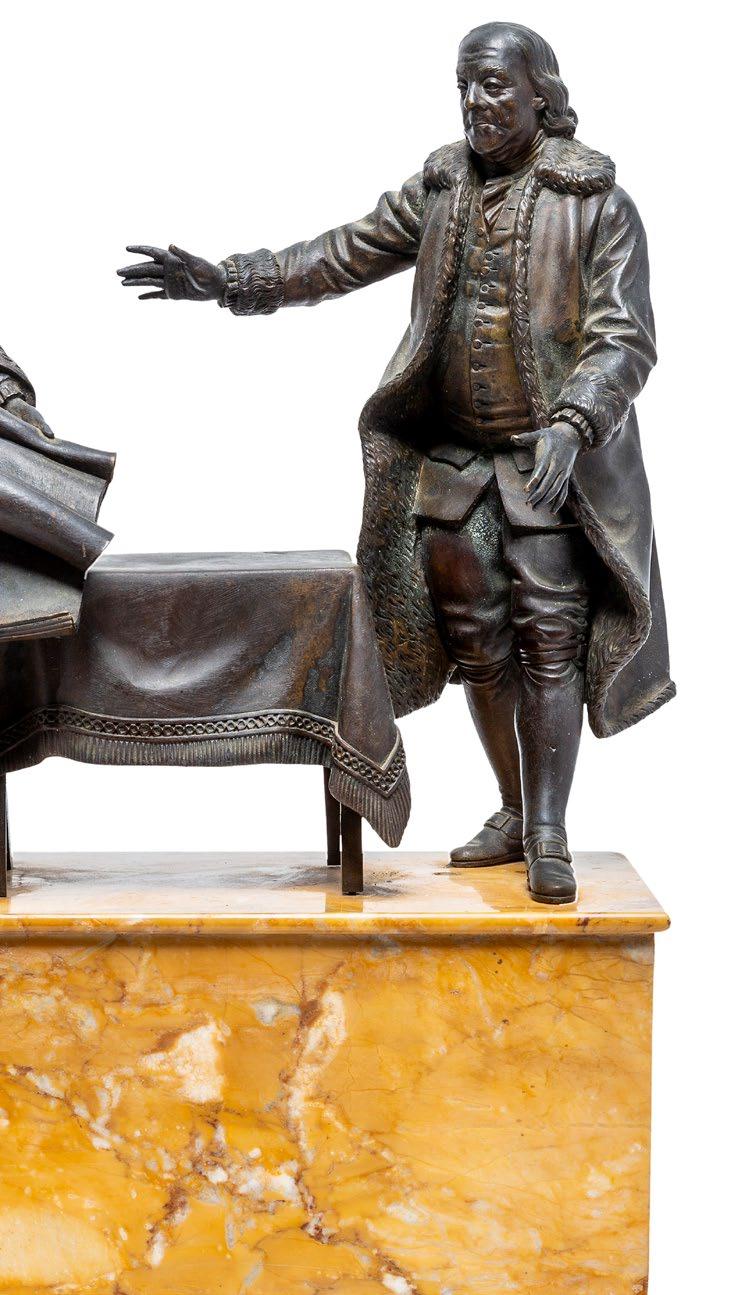
battlefield had earned Washington’s confidence – he succeeded in persuading the American Congress to send a delegation to Versailles. On 3 December 1776, three American plenipotentiaries, the renowned statesman and physicist Benjamin Franklin and the diplomats Silas Deane and Arthur Lee arrived in France, their mission to sign a Treaty with KIng Louis XVI of France at Versailles. The official reception was held at Versailles on 21 March 1778. This treaty marked France’s entry into the war against England. The three men’s simplicity won over not only the French diplomats, but also the hearts of the French people. They were hero-worshipped in Paris and Versailles. After waiting in the Oeil-deBoeuf Room, Benjamin Franklin and his friends were introduced into the King's Great Chamber by the Count of Vergennes. Louis XVI presented them with a note of goodwill for the Congress. The king then sent a considerable amount of military assistance in the form of 6,000 men under the command of Rochambeau. This assistance contributed to the defeat of the English at Yorktown on 17 October 1781. The fate of England was sealed. The definitive Peace Treaty was signed in a hotel in Paris located at 56 Rue Jacob, on 3 September 1783. A related version of this subject matter in bisque-porcelain by Charles Gabriel Sauvage (1741-1827) is in the Metropolitan Museum of Art New York
18

8 19
A superb brass-mounted leather covered velvet-lined chest on gilt-wood stand, French, circa 1730
112cm wide, 80cm deep, 100cm high
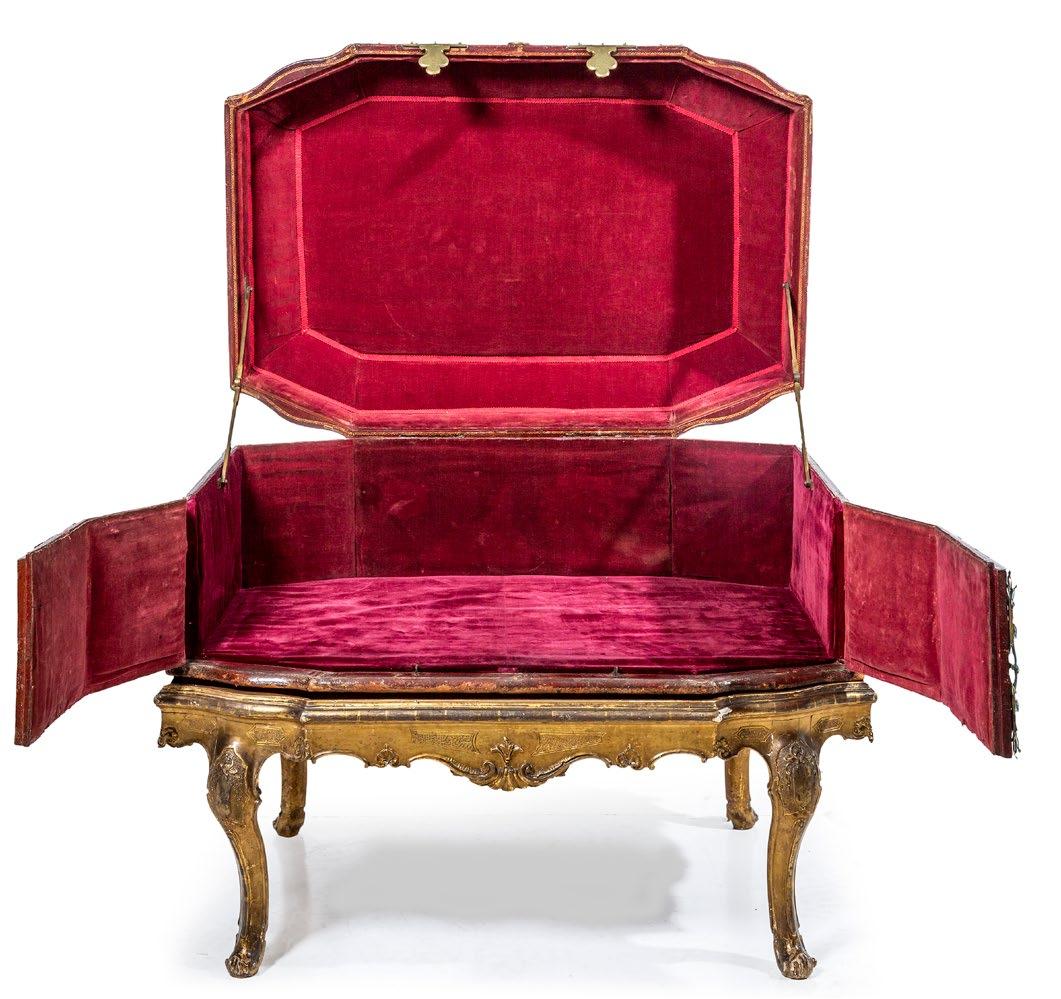

9
20

9 21
A large and extremely impressive carved shell and metal inlaid tortoiseshell dressing case, Italian or Spanish Colonial, 18th century with a mirrored compartment inside 56cm wide, 44cm deep, 21cm high PROVENANCE
A Distinguished Melbourne family collection
$5,000–8,000
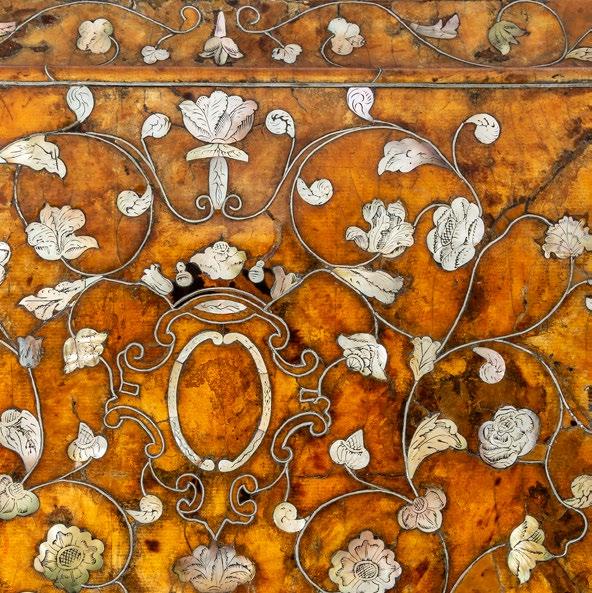
10
22
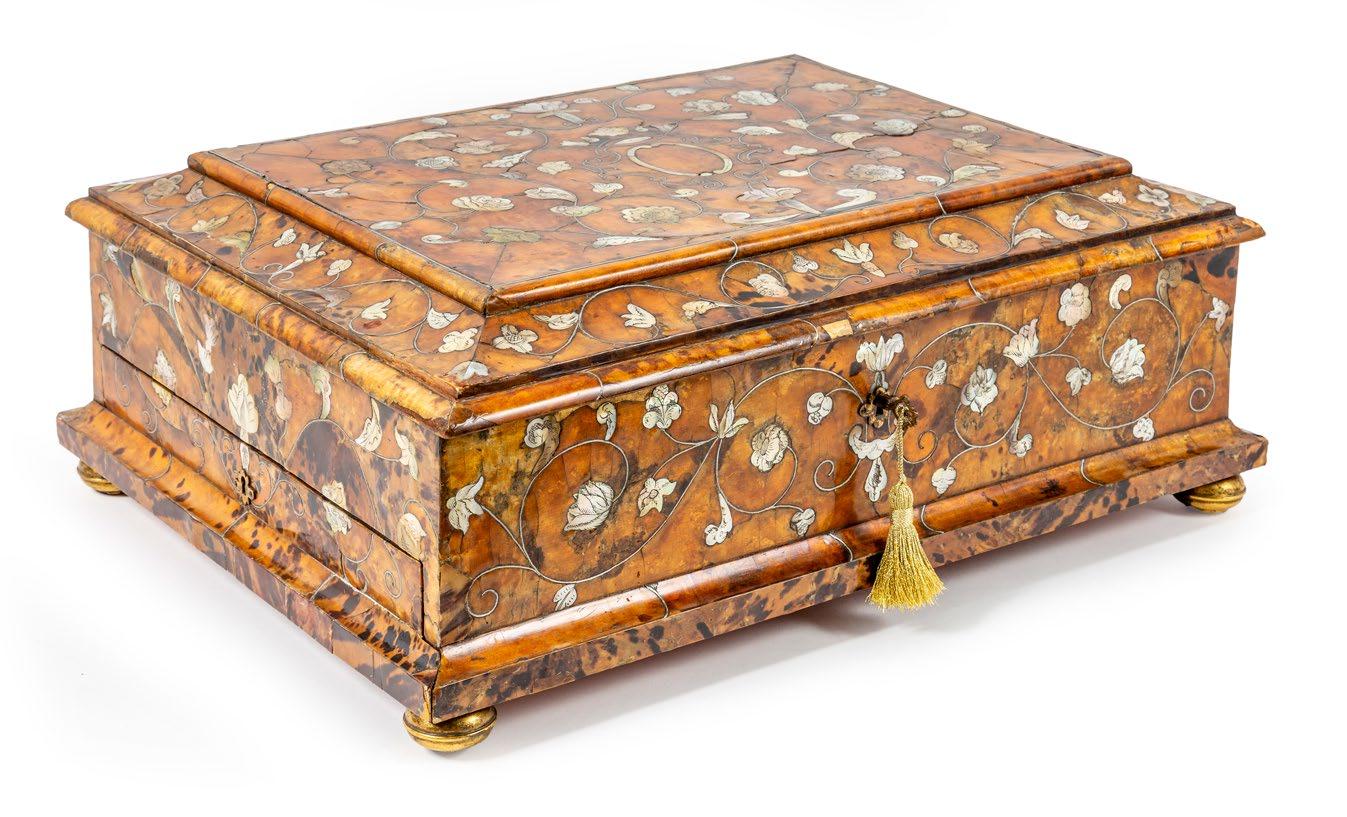
10 23
A fabulous and very rare oyster-laburnum and gilt bronze mounted chest-on-stand, English, circa 1690
171cm high, 113cm wide, 50cm deep
PROVENANCE
The Estate of the Late Lady Burrell, Rosemont, Woollahra, Sydney
$15,000–25,000
Oystering or oyster veneer is a decorative form of veneering, a type of parquetry.
This technique is using thin slices of wood branches or roots cut in crosssection, usually from small branches of walnut, olive, kingwood and less commonly laburnum, yew and cocus.
The resulting circular or oval pieces of veneer are laid side by side in furniture to produce various decorative patterns.
Because the shape formed resembles an oyster shell the technique acquired the name of oyster veneering. This technique is likely to have been developed by English cabinet-makers in the 1660s, immediately after the Restoration of the monarchy, first being used on furniture such as the cocus-wood cabinet on stand which bears the cipher of Queen Henrietta Maria, constructed in circa1661-65, and now at Windsor Castle. Early oyster veneered cabinets were invariably in laburnum, cocus or kingwood. Contemporary longcase clock cases were similarly veneered. Later on softer and more cheaply available woods such as olive and walnut began to be used for oyster veneering, the fashion for such furniture becoming widespread and also spreading to Holland. Oyster veneering fell out of fashion from circa 1710.
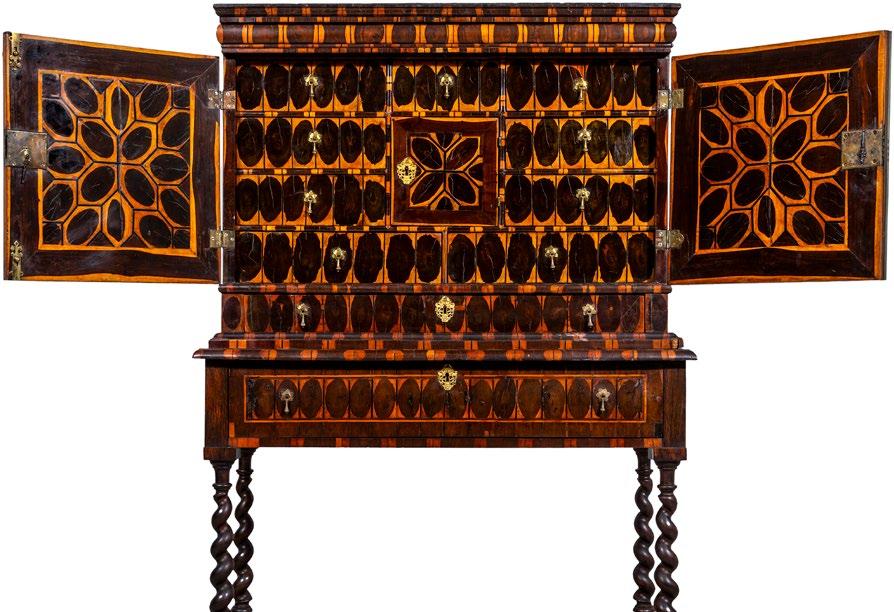
11
24

11 25
A finely carved and very large antique rhinoceros horn on stand, Chinese, Qing Dynasty the carving 1.25kg in weight 55cm long, 16cm at its top, 72cm high when on the carved wood stand. The stand itself is 37cm wide, 33cm high and 17cm deep PROVENANCE
A Private Victorian collection $100,000–150,000

12
26
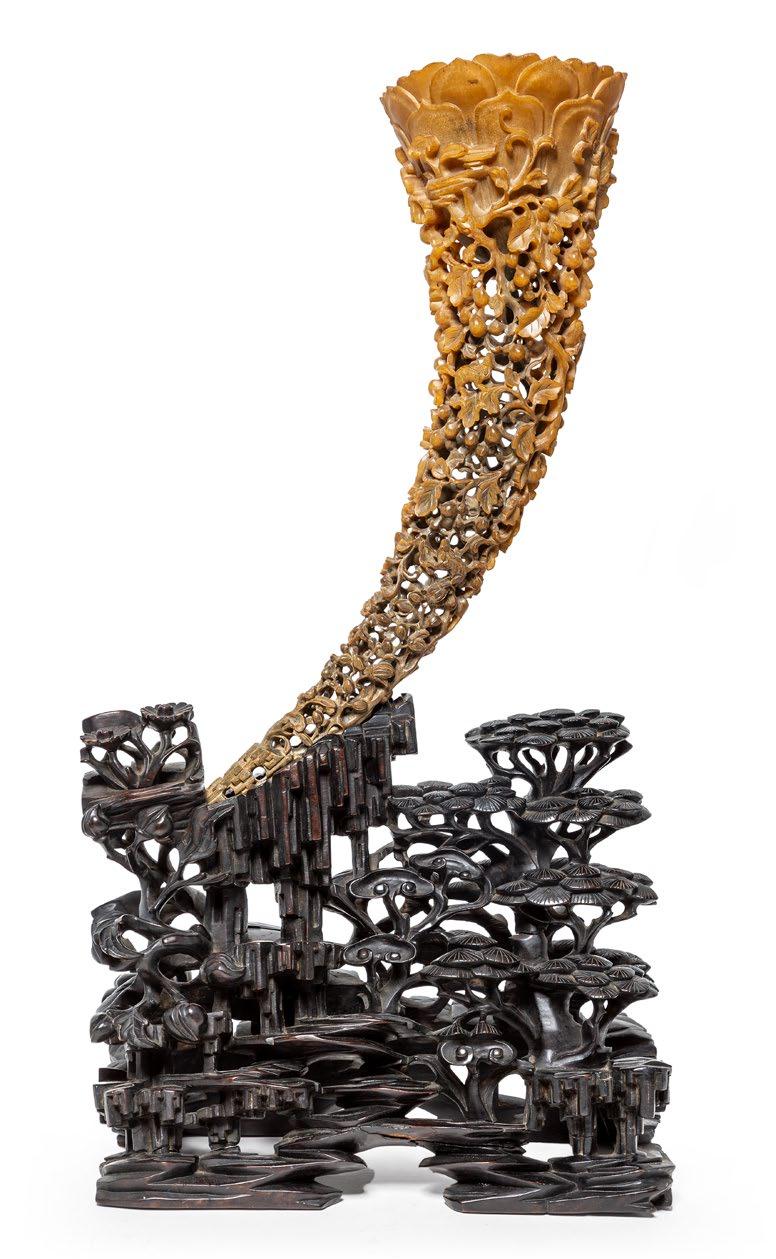
12 27
An exceptionally rare George III mahogany quatrefoil fretwork tray-top table, English, circa 1765
76cm diameter, 77.5cm high
PROVENANCE
A Distinguished family of British aristocratic background, who brought the table to Australia.
NOTE
It is very rare to find a tea-table or wine table with a fretwork tray-top and even more rare to see one with a quatrefoil outline.
$8,000–12,000
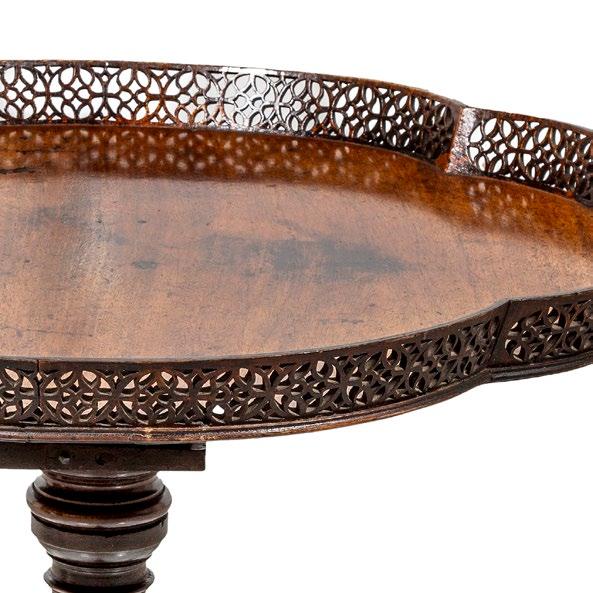
13
28
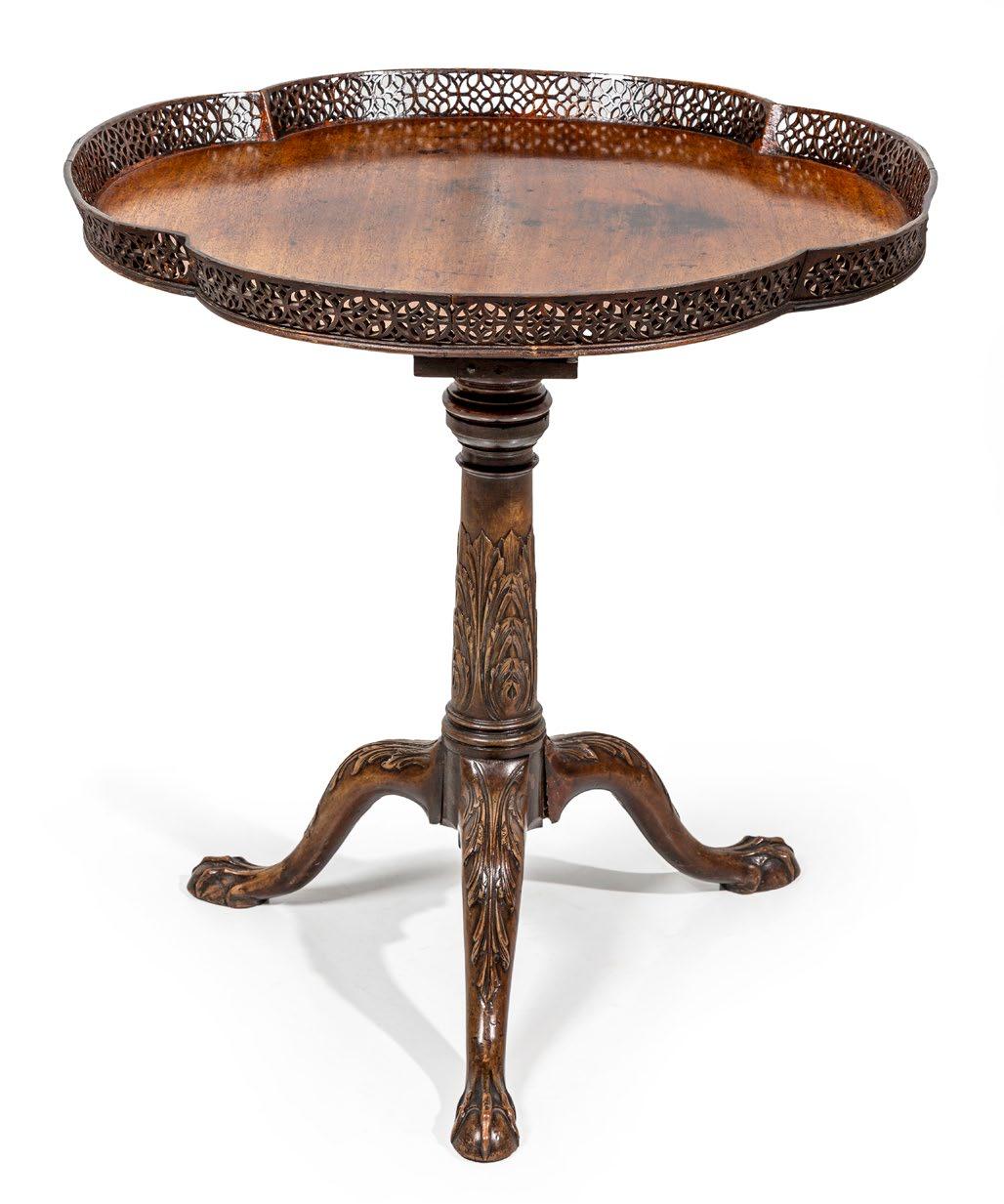
13 29
A pair of massive and spectacular cloisonné tree-planters, Chinese Republic period, early 20th century 104cm diameter, 62cm high
PROVENANCE
A distinguished Melbourne family collection
$15,000–25,000
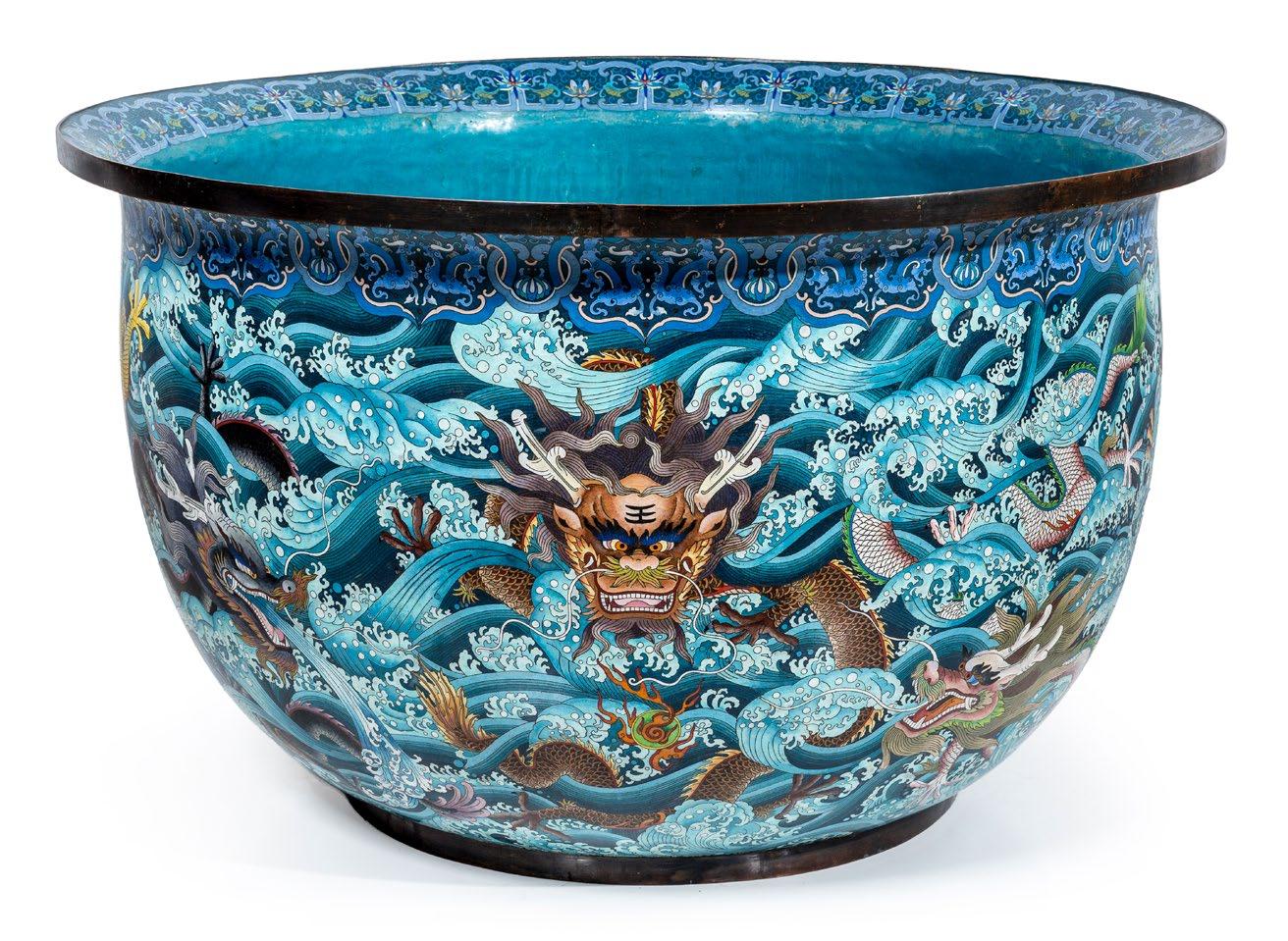
14
30
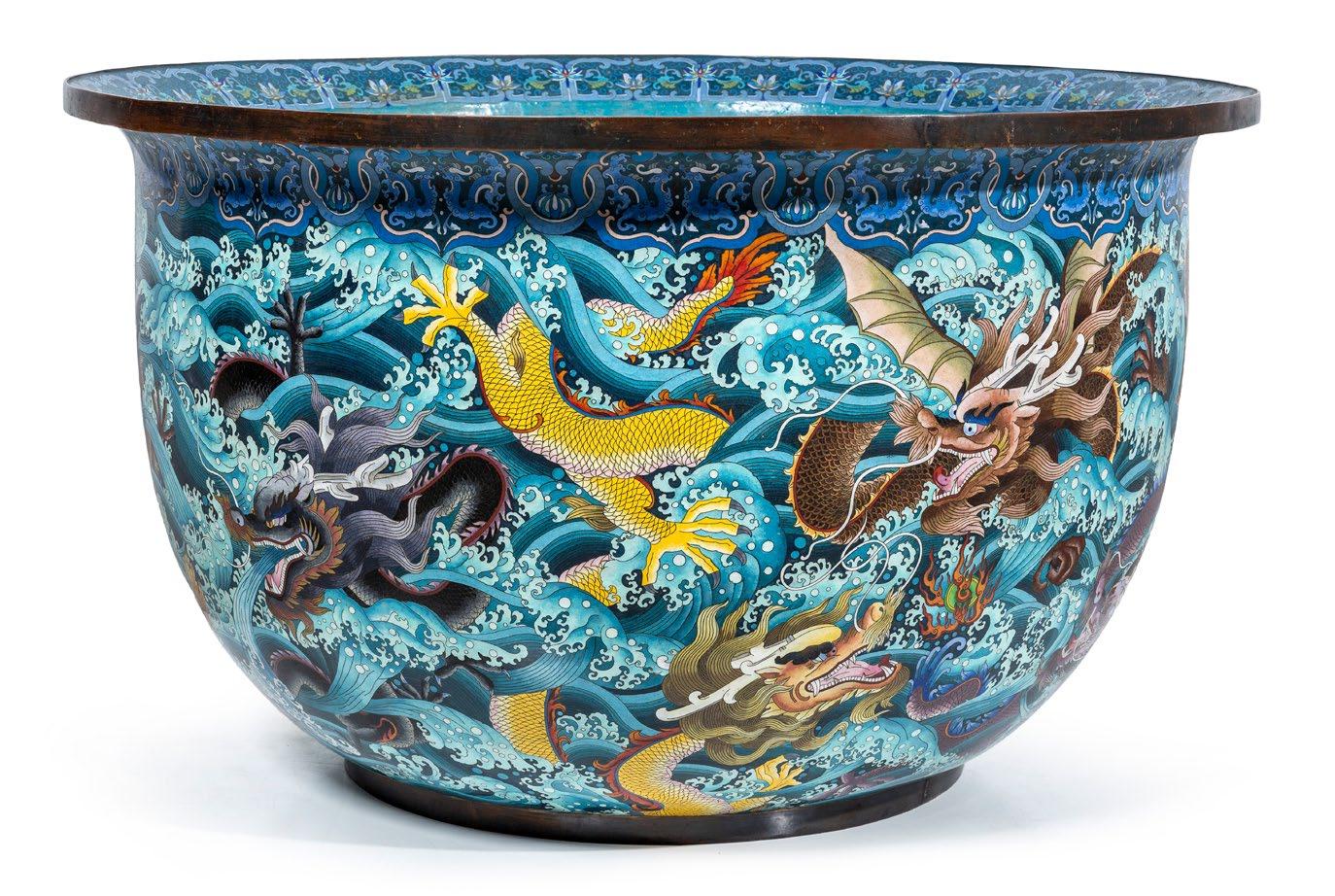
14 31
A fine satinwood and Neo-Classical marquetry oval wine cooler, English, circa 1785
with heavy brass carrying handles and fine brass internal hinges and casters 70cm wide, 54cm deep, 67cm high
PROVENANCE
A highly significant private Sydney collection
$6,000–9,000

15
32

15 33

A fine George III ebony cased bracket clock, maker John Monkhouse, London, English, circa 1765 the dial inscribed Jn Monkhouse London, with two subsidiary dials for regulation and strike/silent the dial with steel chapter ring, fine matt centre, blued steel hands, false pendulum, calendar aperture and central alarm disk with 5 pillar, double fusee movement and pivoted verge escapement, with finely foliate engraved backplate also signed “Jn Monkhouse, London” case 49cm high, 29.5cm wide, dial 17cm wide, 24cm high
PROVENANCE
Private Collection sold Mossgreen, Melbourne, 2 March 2009, lot 12
A highly significant private Sydney collection REFERENCE
John Monkhouse is recorded as a London clockmaker working from 1756 to 1770 see Britten's Old Clocks and Watches and their makers. Surprisingly for such an accomplished clock-maker, not a lot is recorded about John Monkhouse, but we do know that he was in demand, especially in the 1760s in London making fine quality works for longcase, bracket, regulator and table clocks. He was also known for his fine musical long-case and automata clocks.
$8,000–12,000
16
34

16 35
A very rare Irish marquetry and roll top bureau, in the manner of William Moore of Dublin, Irish, circa 1785
with full front writing slide actioning the roll top, the drawer linings in sandalwood bears an old Dublin label to the back 95cm wide, 57cm deep, 117cm high
PROVENANCE
A highly significant private Sydney collection
REFERENCE
The Cabinet-Makers London Book of Prices, London 1793, inside frontispiece, which illustrates a roll-top bureau cabinet with a bureau base of very similar and unusual form to this.
$15,000–20,000

William Moore (1782-1815) served his apprenticeship with the celebrated London firm of Ince and Mayhew where he specialised as a 'marqueteur' prior to the establishment of his own firm in Dublin in 1782. Ince and Mayhew's work from the late 1760’s was increasingly in the emerging neo-Classical manner which was filtering through to Britain from France through the published works of such architects as Delafosse and GillesMarie Oppenord. Although it was not until the publication of Robert and James Adam's Works in Architecture in 1773 (featuring Robert Adam's neo-Classical interiors at Kenwood, 1768-71 and Osterley Park, 1767-80) that the transition was completed. Ince and Mayhew were best known for their skilled and innovative use of marquetry and were able to put themselves at the vanguard of the new fashion and it is within this environment that Moore's work must be considered. Ince and Mayhew's mature neo-Classical marquetry depended upon a vocabulary of largescale motifs, such as urns, tripods and swags 'coloured and boldly inlaid upon contrasting fields (and) subtle foliage inlaid in different woods', often fruit woods such as pear, holly, plum and harewood.
Moore's apprenticeship with Ince and Mayhew provided him not only with the finest skill as a cabinetmaker and marquetry specialist, but also with an education in contemporary taste and design that enabled him to set up on his own in 1782. Keen to open his own firm and with the high end of the London market saturated with firms such as Thomas Chippendale, John Cobb, John Linnell and of course, Ince and Mayhew, Moore moved to Dublin and this proved to be well-timed and profitable, due to the birth of Dublin's Georgian New Town and the massive increase in demand for fashionable cabinet-makers. A situation closely comparable to that in Edinburgh and the sudden success of cabinet makers such as William Trotter. Moore's first known premises were in Abbey Street, 1785-90 and subsequently larger premises in Capel Street, where he remained until his death in 1815. Moore advertised his new business in the Dublin Post in 1782 in which he specifically refers to his new expertise with inlay and his training under Ince and Mayhew:
‘William Moore most respectfully acknowledges the encouragement he has received, begs leave to inform those who may want Inlaid work, that by his close attention to business and instructions to his men, he has brought the manufacture to such perfection, to be able to sell for almost one half his original prices; as the greatest demand is for Pier Tables, he has just finished in the newest taste a great variety of patterns, sizes and prices, from three guineas to twenty; Card tables on a new construction (both ornamented and plain) which appear like small Pier Tables, with every article in the inlaid Way, executed on shortest notice, and hopes from his long experience at Messrs. Mayhew and Ince, London, his remarkable fine coloured woods, and elegant finished work, to meet the approbation of all who shall please to honour him with their commands'.
17
36
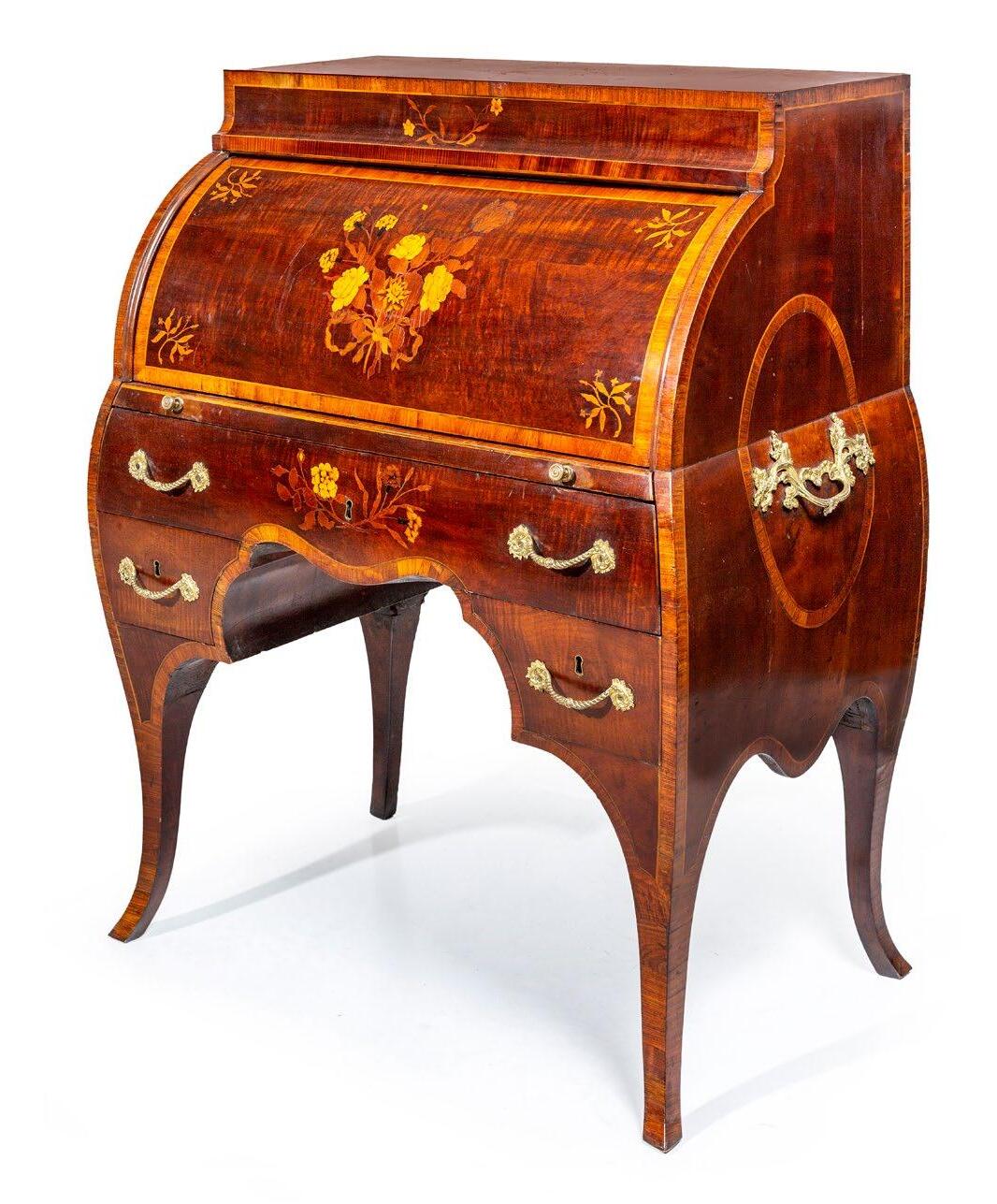
17 37
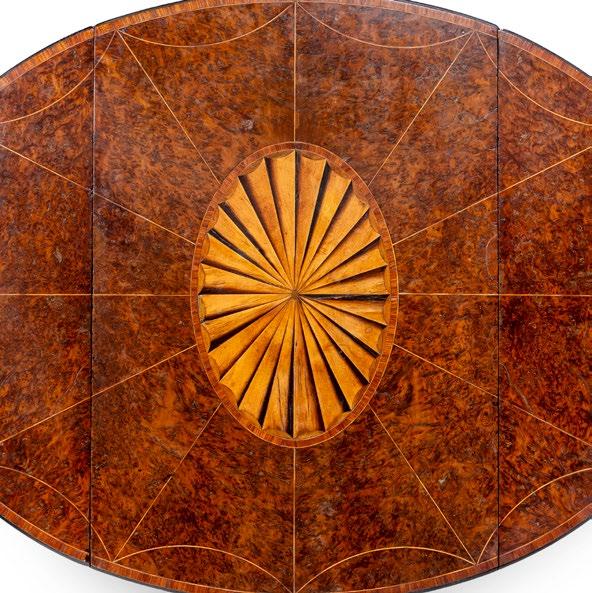
A fine and rare burr-yew, oak, sycamore and boxwood neoclassical marquetry oval Pembroke table, in the manner of Mayhew and Ince, English, circa 1775
with original brass handles, and casters 71cm long, 70cm high, 49cm wide closed, 97cm wide open
REFERENCE
See Sotheby's London, Important Furniture, 6 December 2011, lot 105 for an identical example which sold for 18,750 pounds
$12,000–18,000
In 1762 Mayhew and Ince published the “Universal System of Household Furniture” dedicated to the Duke of Marlborough. It was a folio of drawings and descriptions in both English and French that was produced in direct competition to their biggest trade competitor Thomas Chippendale. Chippendale’s “The Gentleman and Cabinet Makers Director” (which Ince had been a subscriber to) that had first been published in 1754 and circulated around the country of England to the mainly aristocratic subscribers. Fairly quickly it became the industry
standard amongst regional and colonial cabinet-makers. It established Chippendale’s name, not only as a manufacturer of furniture but possibly the first interior designer, advising his noble clients on their overall project, from the colour of their walls to their soft furnishings. Mayhew and Ince quickly realised the commercial benefits of producing such a body of work and quickly followed suit. Mayhew and Ince’s style was far more classical than that of Thomas Chippendale with elaborate use of timber, inlaid woods and marquetry. They worked closely with Robert Adam, most notably for Sir John Whitwell at Audley end in 1767, for the Duchess of Northumberland in 1771, for the Earl of Kerry in 1771 and, most importantly for the Duchess of Manchester in 1775 creating the Kimbolton Cabinet. Mayhew and Ince also provided furnishings for Humphry Sturt at Crichel House, Dorset, where James Wyatt was providing designs for the interiors.
The firm was prominent enough to be commissioned to vet Dominique Daguerre’s bills for furnishing Carlton House, 1783–89, but none of their production for the Prince of Wales nor the Royal Family has been identified. The two partners married sisters, in a double wedding at the fashionable church of St. James’s, Piccadilly, 20 February 1762.
18
38

18 39

A very impressive and very large pair of silvered and gilt-wood wall torcheres, Italian, 18th century
170cm high, 92cm wide, 50cm deep
$6,000–9,000
These magnificent wall lights are typical of the very theatrical designs in Italian architecture and interiors of the 17th century and 18th century that showed none of the restraint that you see in some other European countries at the time, especially England.
The use of gilding and silvering adds to the effect and you can imagine how these would have looked, lit up, in the entrance way of a grand Palazzo.
19
40

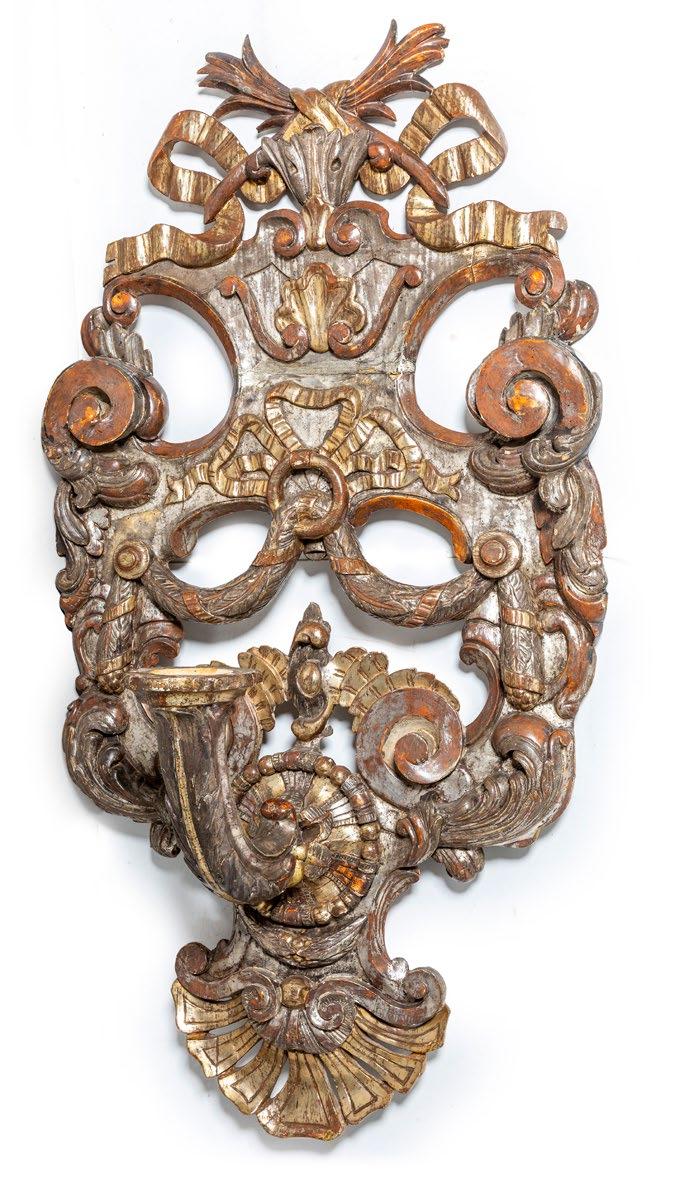
19 41
A fine Regency rosewood and parcel-gilt writing table, English, circa 1820
102cm wide, 63cm deep, 75cm high
PROVENANCE
Martyn Cook Antiques, Sydney
A highly significant private Sydney collection
$7,000–10,000
This wonderful example of Regency design displays just how exciting furniture design was at this time in England. There is a great balance and restraint of decoration and a strong linear form that pays homage to Classical design and architecture. Regency furniture of this type stands proud and hasn't dated in the way that some Victorian furniture has, as with its pure lines and very considered design, such a piece works just as well in a modern glass and steel building, as it does in a more traditional interior.
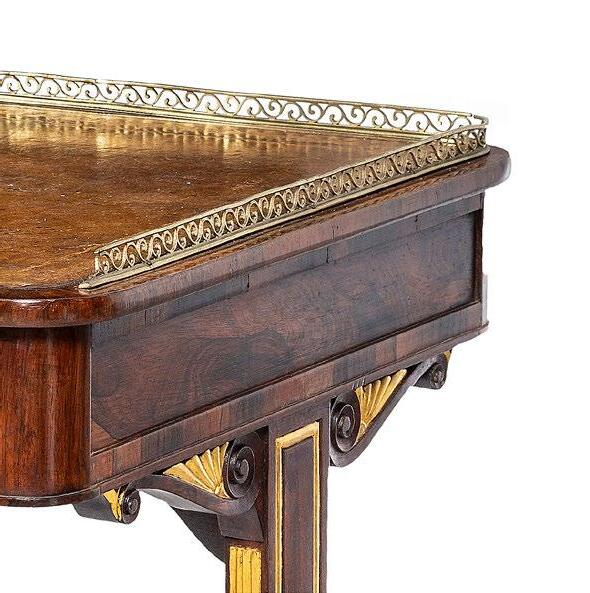
20
42
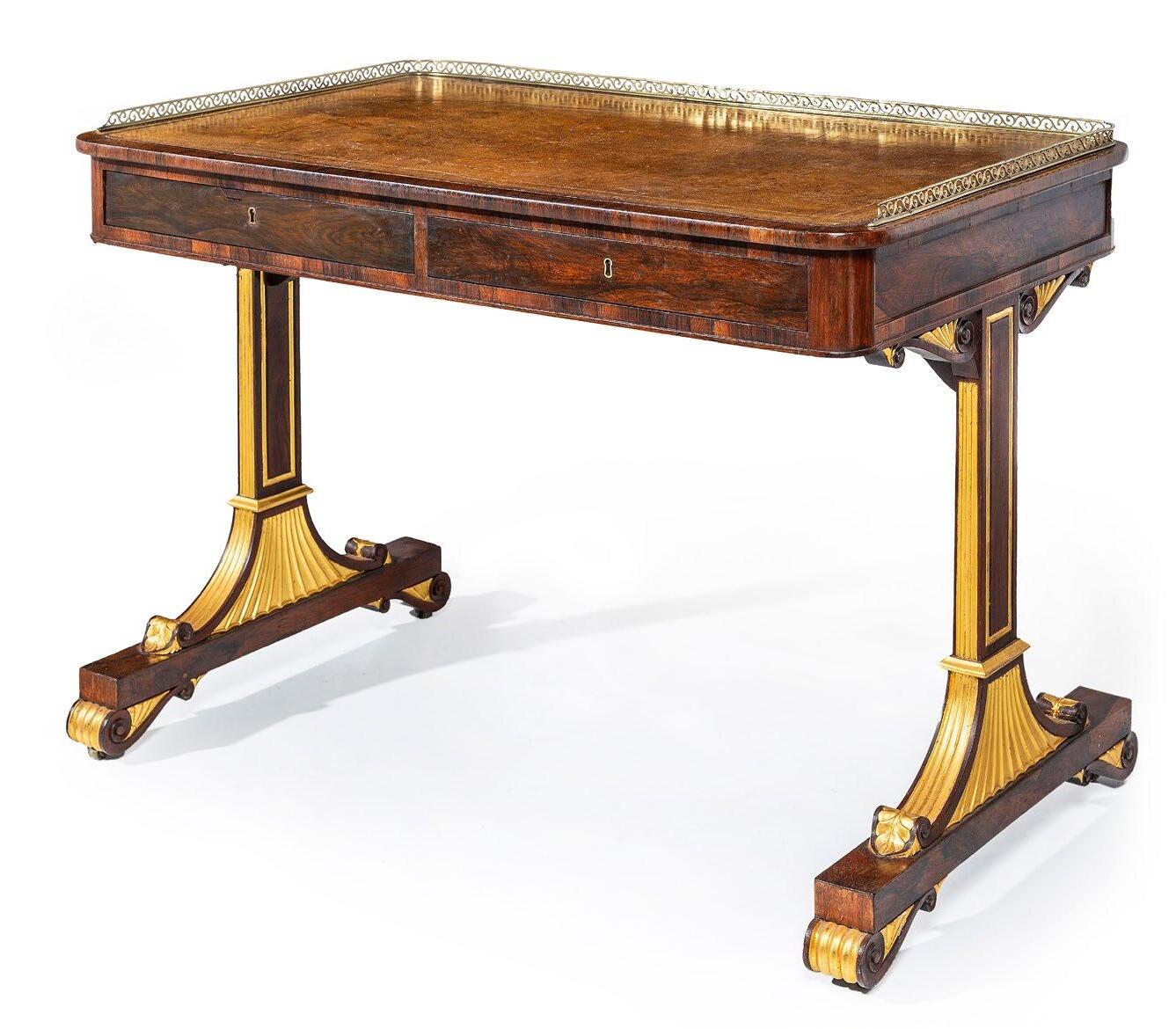
20 43
A fine Louis XVI period landscape tulipwood and marquetry and gilt-bronze mounted table-a-ecrire, French, circa 1770 with later alterations to the top 86cm wide, 45cm deep closed, 71cm high
PROVENANCE
Probably Charles William Vane 3rd Marquess of Londonderry (17781854) and Frances Anne, Marchioness of Londonderry (1800-1865) and thence by descent
Christie's London, Works of Art from the Marquesses of Londonderry, 22/23 May 2014, Lot 461
A highly significant private Sydney collection.
REFERENCE
Londonderry House Inventory 1886 p.55, yellow drawing room, '34' tulipwood marquetry table sliding top inlaid with views, ormolu mounted' Royal Aero Club, Londonderry House inventory, 1949, p.6, library. Illustrated in situ in the drawing room of Alexander Charles Robert Vane-Tempest-Stewart, 9th Marquess of Londonderry (1937-2012) at his Hampstead home circa 1965.
NOTE
The unusual marquetry landscape panels in this table a ecrire are closely related to those employed amongst the known oeuvre of the ebeniste
Jacques Dautriche (d.1778) Maitre 24 May 1765. Several known tables with sliding tops by Dautriche are known to exist, see Christie's Monaco, 16/17 June 2001, lot 661 and also Christie's Paris, 18 June 2002, lot 661.
$12,000–18,000
The Dutchman Jacques van Oostenrijk, called Dautriche, was born in the Netherlands between 1725-1728 and arrived in Paris around 1743. He worked for some 20 years before attaining his maîtrise in 1765 - largely due to the fact that it was difficult for an outsider to amass the requisite fees and meet the stringent requirements of the guild. He worked as an ouvrier libre and in the 1750s worked for such craftsmen as Pierre II Migeon and Denis Genty. After achieving his maîtrise he moved into a more prestigious location in the rue Traversière, moving towards the end of his life to the rue du Faubourg Saint-Antoine. Through the marriage of one his children he became allied with Pierre Boichod (ébéniste privilégié du roi) whose establishment was near to that of Joseph Baumhauer, one of the most talented and progressive craftsmen of the period. Dautriche spent his entire career as a furniture maker; his most important commission was for the Comte d'Artois for whom he made ten commodes for the Palais du Temple between June and September 1777.
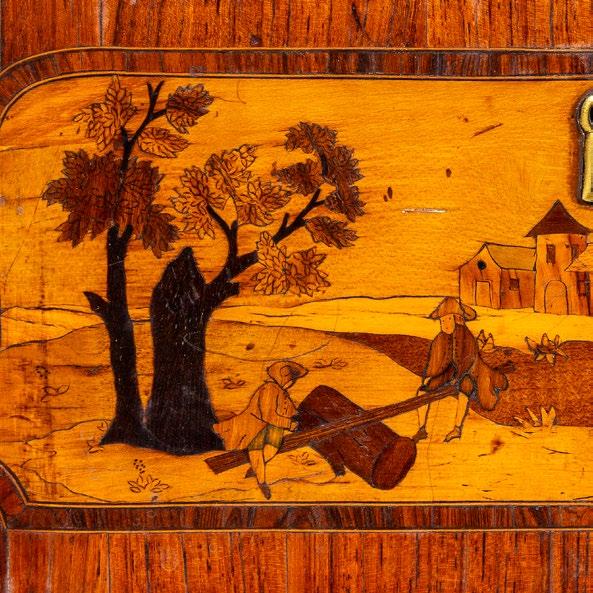
21
44

21 45
An important pair of lion-mask dining chairs, originally gilded, English, 18th century
with the remains of the original gilding and gesso to the under-frames
64cm wide, 104cm high at the back, seat 48cm high from the floor
PROVENANCE
Acquired at auction in the US
A highly significant private Sydney collection
EXHIBITED
For many years until recently at The Union Club, Bent Street, Sydney
$20,000–30,000
These chairs relate to an important suite created by James Moore for Stowe House in England and it would be exciting to think they might possibly have once been part of a large suite of seat-furniture which includes chairs, together with matching settees, stools and a pair of side tables. Now in various private collections, the group, until William Reider published an article titled 'A Gilt Gesso Set of Furniture Traditionally from Stowe', in The Journal of The Furniture History Society, Volume XIV, 1978, had become 'entrenched in the literature as from Stowe and by James Moore' (op. cit. p. 9). Also, it seems that it was originally assumed that the suite as a whole dated from the 18th century, but it is now clear that the majority of the chairs at least were actually made in the late 19th century. See a pair thought to be circa 1900 that sold Sotheby's Important English Furniture NY 16 October 2008 lot 190 where they sold for US$53,125.00.
The major contents of Stowe House, Buckinghamshire, the ducal mansion of the Dukes of Buckingham and Chandos, were dispersed in a major sale in 1848, occasioned by the financial difficulties of Richard Grenville, the second Duke. Unfortunately, both the entries found in 'Inventory of the Household Furniture &c at Stowe House' taken in 1839, or the descriptions in the 1848 sale catalogue, are insufficiently detailed to allow a positive identification to be made with the suite as a whole which, according to Rieder. included at least thirty-five pieces. Of these, there are a number of chairs recorded very similar to the present examples which are now in the Collection of her Majesty the Queen including a set of six in the Queen's Audience Room at Windsor Castle
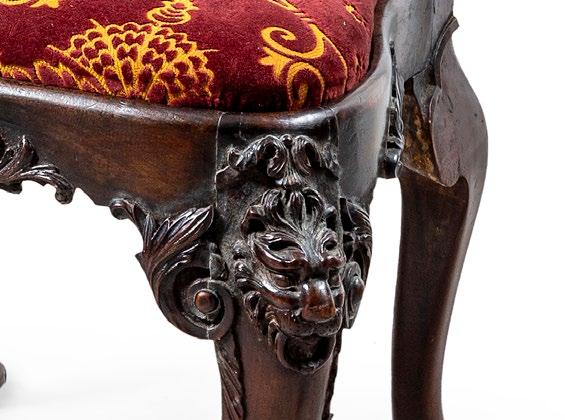
which was sold at Christie's in London in May 1939 from the Collection of William Randolph Hearst, being described as 'From the Collection of the Duke of Buckingham and Chandos, Stowe House', and a further twenty-two chairs, twenty-one being in the Queen's Drawing Room and Presence Chamber, and another in a store-room. These were acquired from Sotheby's in London in two sales, twelve being sold on January 31, 1964, and ten on July 2 1965, two of these being described as circa 1725, 'the rest later'. They were sold by the descendants of the daughter of the South African mining magnate Sir Joseph P. Robinson who had almost certainly acquired them during his tenancy of Dudley House, Park Lane in the late 19th and early 20th century. Dudley House was the London residence of Lord Ward, Ist Earl of Dudley, being subsequently leased by his son, the 2nd Earl of Dudley in 1895 to Sir Joseph P. Robinson.
Presumably Sir Joseph acquired twelve of the chairs during this tenancy, these appearing in a photograph taken in 1890 of the Dining Room at the time of the second Earl, and it is of course possible that the other ten chairs were also at Dudley House at that time, but in another room. Lord Ward is recorded as purchasing at the Stowe sale, lot 1338, A set of four chairs, with carved backs and legs, with lions' masks and feet, the seats covered with crimson Utrecht velvet, which, in a priced and annotated catalogue published after the sale by Henry Ramsey Forster, it was noted that they had been 'presented to the Duke of Buckingham by Mr. W. Selby Lowndes'. Of the twenty-two chairs with the Dudley House provenance now in the Royal Collection, Rieder observes that 'two or three appear to be authentic' (op. cit. p. 8), which neither proves nor disproves that they are the ones originally purchased from Stowe, and which were presumably subsequently copied by Lord Ward. It is interesting to note that another six identical chairs are recorded, the whereabouts of which are currently unknown, although they might possibly be those also in the Royal Collection and which were formerly in the collection of William Randolph Hearst. These were in the collection of Sir Lionel Phillips, Bart., and were sold at Christie, Manson & Woods, London, May 6, 1918, lot 748. Sir Lionel was a contemporary of Sir Joseph Robinson and was also a South African mining magnate. Apart from the chairs, two settees are also in the Collection of Her Majesty the Queen at Windsor Castle, and although formerly in the Collection of William Randolph Hearst also lack a secure provenance, and another one in The Metropolitan Museum of Art, New York, which was formerly in the Collection of Sir Everard Pauncefort Duncombe of Great Brickhill Manor, Bucks. His predecessor Sir Philip Pauncefort Duncombe, the 1st Baronet (1818-1890), is recorded as a purchaser at the Stowe Sale, although it cannot be identified as coming from that sale.
The Metropolitan Museum's collection also includes a stool, formerly in the Mulliner Collection, similarly without an earlier provenance, although another pair of stools, now at Parham Park, was originally in the Collection of Col. W. Selby Lowndes of Whaddon Hall, Bucks., as was a pair of tables now in a private American collection. W. Selby Lowndes is also recorded as a purchaser at the Stowe sale, but again cannot be identified. All of these pieces appear to date from the 18th century, although the carved gesso decoration to the tops of the tables is later. See: William Rieder, 'A Gilt Gesso Set of Furniture Traditionally from Stowe', The Journal of the Furniture History Society, vol. XIV, 1978, pl. 21 Macquoid and Edwards, The Dictionary of English Furniture, 1953, vo. I., p. 270, fig. 13
22
46

22 47
A fine shell-design marquetry and floral painted satinwood Pembroke table, English, circa 1785
with oval Sheffield silver-plated handles to the drawer
76.5cm long, 46.5cm wide closed, 96.5cm wide open, 72cm high
PROVENANCE
Martyn Cook Antiques, Sydney
A highly significant private Sydney collection
$5,000–8,000

23
48
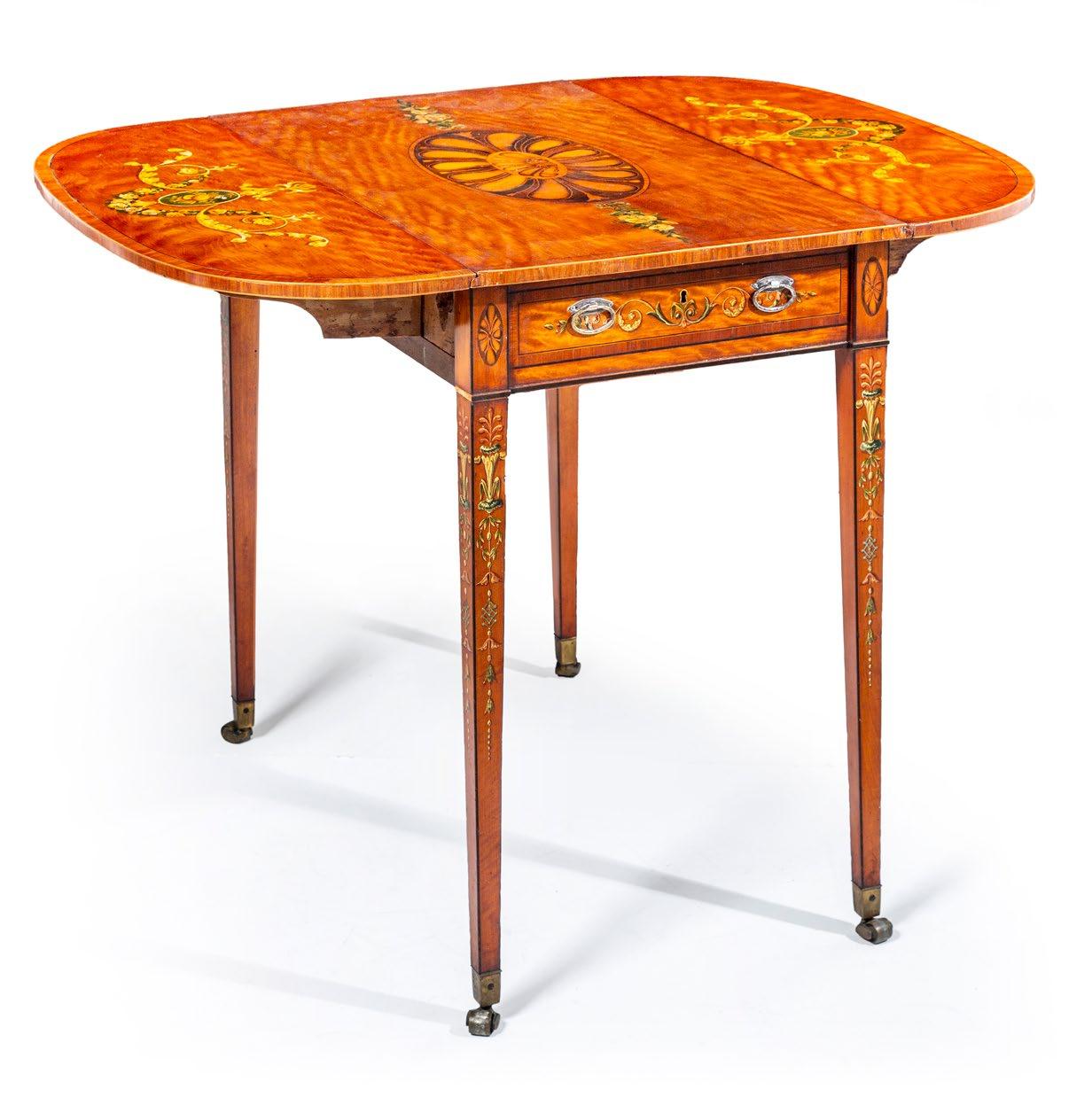
23 49
A fine and restrained satinwood-crossbanded and boxwoodstrung roll-top desk, attributed to Gillows and Company, English, circa 1785
94cm wide, 60cm deep, 161cm high
PROVENANCE
A highly significant private Sydney collection
EXHIBITED
For many years until recently at The Union Club, Bent street, Sydney
$4,000–6,000
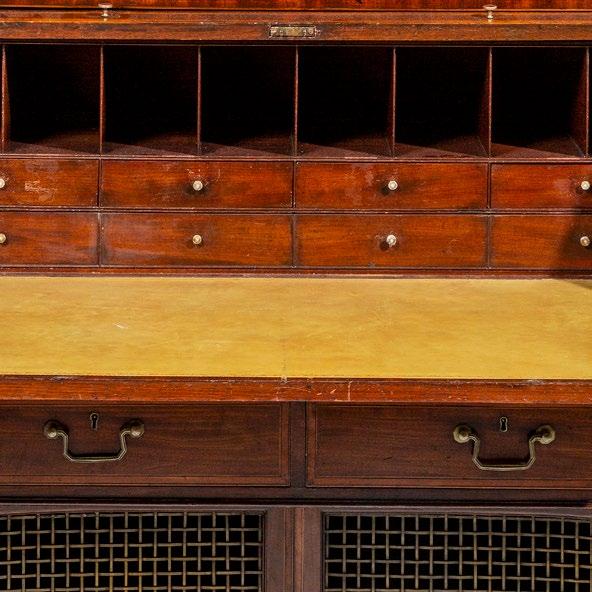
The Gillow family of Master cabinet-makers (1728–1814).
In 1728 Robert Gillow began trading in Lancaster as a joiner, builder, house carpenter, furniture maker and overseas merchant. By the summer of 1731 he had entered into a partnership with a fellow catholic, George Haresnape, which had ended by 1735. By 1734 six other names appeared on their staff list. Gillows notably made heavy use of mahogany wood, which is indigenous to the Americas, from the early 1730s.In the early 1740s, Gillow owned a twelfth share of the ship Briget, which he partially used to import mahogany from the West Indies. The success of the firm was partly due to his ability to directly import mahogany; by 1742 Gillow was exporting finished mahogany furniture back to the West Indies.
On 1 January 1757 Robert entered into an equal partnership with his son Richard Gillow (1733–1811), and the firm was known as Robert Gillow & Son. Richard was also the architect for several buildings in Lancaster. He financed the building of the Catholic church in Dalton Square, Lancaster in 1798. The family's Catholic history was important in building up a customer base within Lancashire's gentry, and their subsequent purchase of Leighton Hall, Lancashire from a cousin in 1822. On 31 December 1768 Robert Gillow I retired and left his share of the firm to his other son, Robert Gillow II (1747–1795). In 1769 and 1770, a shop at 176 Oxford Street, London, was sent up by the brothers' cousin, Thomas Gillow (1736–1779), to sell their furniture. (Gillow & company's London branch remained on this site until 1906, when the newly-merged Waring & Gillow built a new store nearby; Selfridges now stands on the site of the vacated store).
END OF SALE
24
50
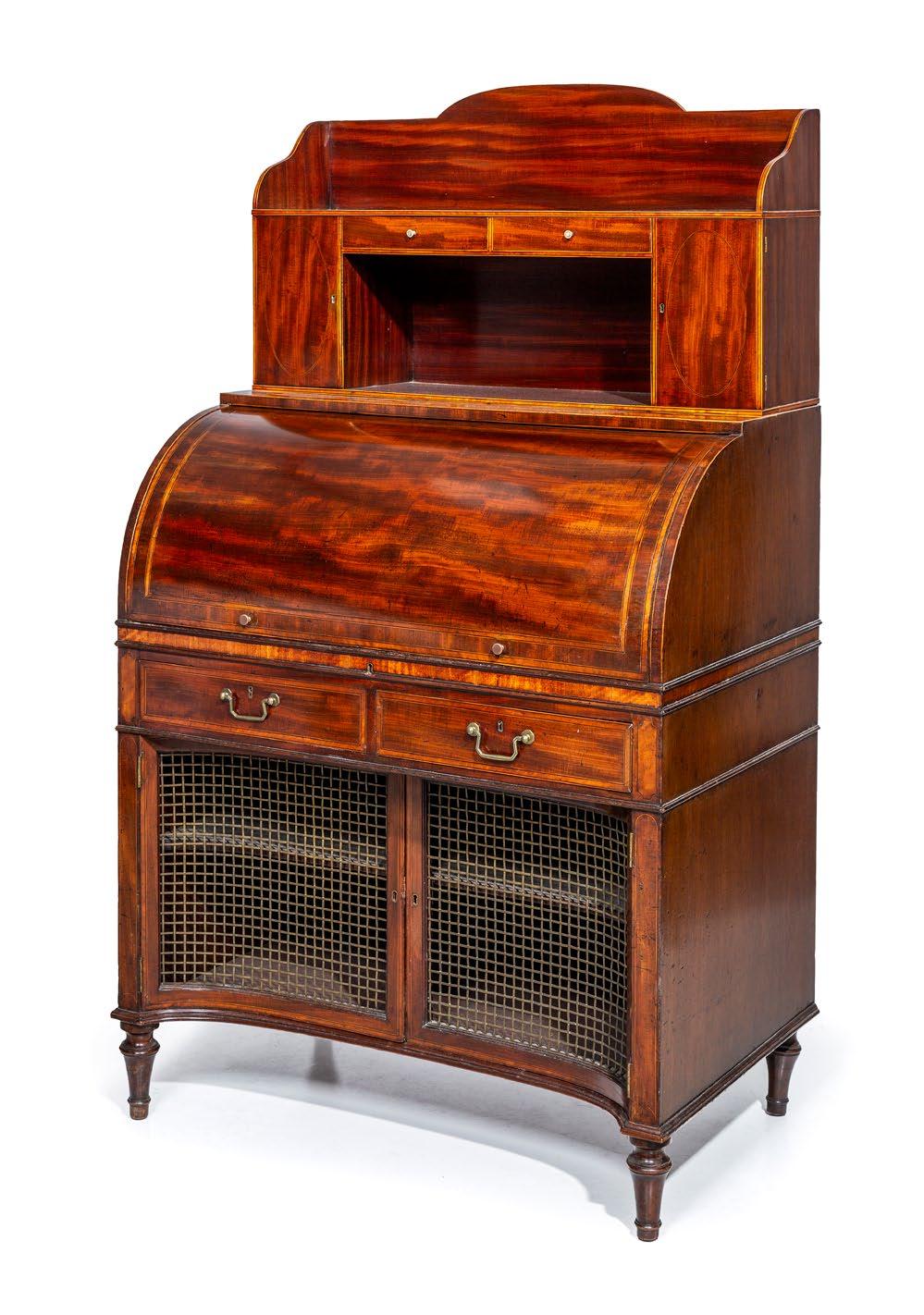
24 51
Terms and Conditions of Sale
The terms and conditions of sale listed here contain the policies of Artvisory Pty Ltd. They are the terms on which Artvisory Pty Ltd and the Seller contract with the Buyer. They may be amended by printed Saleroom Notices or oral announcements made before and during the sale. By bidding at auction you agree to be bound by these terms.
1. Background to the Terms used in these Conditions
The conditions that are listed below contain terms that are used regularly and may need explanation. They are as follows:
“the Buyer” means the person with the highest bid accepted by the Auctioneer
“the Lot” means any item depicted within the sale for auction and in particular the item or items described against any lot number in the catalogue.
“the Hammer price” means the amount of the highest bid accepted by the auctioneer in relation to a lot
“the Buyers Premium” means the charge payable by the Buyer to the auction house as a percentage of the hammer price.
“the Reserve” means the lowest amount at which Artvisory has agreed with the Seller that the lot can be sold.
“Forgery” means an item constituting an imitation originally conceived and executed as a whole, with a fraudulent intention to deceive as to authorship, origin, age, period, culture or source, where the correct description as to such matters is not reflected by the description in the catalogue. Accordingly no lot shall be capable of being a forgery by reason of any damage or restoration work of any kind (Including re-painting).
“the insured value” means the amount that Artvisory in its absolute discretion from time to time shall consider the value for which a lot should be covered for insurance (whether or not insurance is arranged by Artvisory.)
All values expressed in Artvisory Pty Ltd catalogues (in any format) are in Australian Dollars (AU$). All bids, “hammer price”, “reserves”, “Buyers Premium” and other expressions of value are understood by all parties to be in Australian Dollars (AU$) unless otherwise specified.
2. Artvisory Auctions as Agent
Except as otherwise stated Artvisory Pty Ltd acts as agent for the Seller.
The contract for the sale of the property is therefore made between the Seller and the Buyer.
3. Before the Sale
a) Examination of Property
Prospective Buyers are strongly advised to examine in person any property in which they are interested before the Auction takes place. Neither Artvisory nor the Seller provides any guarantee in relation to the nature of the property apart from the Limited warranty in the paragraph below. The property is otherwise sold “AS IS”
b) Catalogue and other Descriptions
All statements by Artvisory in the catalogue entry for the property or in the condition report, or made orally or in writing elsewhere, are statements of opinion and are not to be relied upon as statements of fact. Such statements do not constitute a representation, warranty or assumption of liability by Artvisory of any kind. References in the catalogue entry to the condition report to damage or restoration are for guidance only and should be evaluated by personal inspection by the bidder or a knowledgeable representative. The absence of such a reference does not imply that an item is free from defects or restoration, nor does a reference to particular defects imply the absence of any others. Estimates of the selling price should not be relied on as a statement that this is the price at which the item will sell or it’s value for any other purpose. Neither Artvisory nor The Seller is responsible for any errors or omissions in the catalogue or any supplemental material. Images are measured height by width (sight size). Illustrations are provided only as a guide and should not be relied upon as a true representation of colour or condition. Images are not shown at a standard scale. Mention is rarely made of frames (which may be provided as supplementary images on the website) which do not form part of the lot as described in the printed catalogue.
Foreign buyers should note that all transactions are in Australian dollars so there may be a small exchange rate risk. The costs associated with acquiring a good certificate will be carried by the purchaser. If the item turns out to be forged or otherwise incorrectly described, all reasonable costs will be borne by the vendor.
c) Buyers Responsibility
All property is sold “as is” without representation or warranty of any kind by Artvisory or the Seller. Buyers are responsible for satisfying themselves concerning the condition of the property and the matters referred to in the catalogue by requesting a condition report
No lot to be rejected if, subsequent to the sale, it has been immersed in liquid or treated by any other process unless the Auctioneer’s permission to subject the lot to such immersion or treatment has first been obtained in writing.
4. At the Sale
a) Refusal of Admission
Artvisory reserves the right at our complete discretion to refuse admission to the auction premises or participation in any auction and to reject any bid.
b) Registration before Bidding
Any prospective new buyer must complete and sign a registration form and provide photo-identification before bidding. Artvisory may request bank, trade or other financial references to substantiate this registration.
c) Bidding as a Principal
When making a bid, a bidder is accepting personal liability to pay the purchase price including the buyers premium and all applicable taxes, plus all other applicable charges, unless it has been explicitly agreed in writing with Artvisory before the commencement of the sale that the bidder is acting as agent on behalf of an identified third party acceptable to Artvisory and that Artvisory will only look to the principal for payment.
d) International Registrations
All International clients not known to Artvisory will be required to scan through an accredited form of photo identification and pay a deposit at our discretion in cleared funds into Artvisory’s account at least 24 hours before the commencement of the auction. Bids will not be accepted without this deposit. Artvisory also reserves the right to request any additional forms of identification prior to registering an overseas bid. This deposit can be made using a credit card, however the balance of any purchase price in excess of $5,000 can not be charged to this card without prior arrangement.
This deposit is redeemable against any auction purchase.
e) Absentee bids
Artvisory will use reasonable efforts to execute written bids delivered to us AT LEAST 24 Hours before the sale for the convenience of those clients who are unable to attend the auction in person. If we receive identical written bids on a particular lot, and at the auction these are the highest bids on that lot, then the lot will be sold to the person whose written bid was received and accepted first. Execution of written bids is a free service undertaken subject to other commitments at the time of the sale and we do not accept liability for failing to execute a written bid or for errors or omissions which may arise. It is the bidder’s responsibility to check with Artvisory after the auction if they were successful. Unlimited or “Buy” bids will not be accepted.
f) Telephone bids
Priority will be given to overseas and interstate bidders. Please refer to the catalogue for the Telephone Bids form. Arrangements for this service must be confirmed AT LEAST 24 HOURS PRIOR to the auction commencing. Artvisory accepts no responsibility whatsoever for any errors or failure to execute bids. In telephone bidding the buyer agrees to be bound by all terms and conditions listed here and accepts that Artvisory cannot be held responsible for any miscommunications in the process. The success of telephone bidding cannot be guaranteed due to circumstances that are unforeseen. Buyers should be aware of the risk and accept the consequences should contact be unsuccessful at the time of Auction. You must advise Artvisory of the lots in question and you will be assumed to be a buyer at the minimum price of 75% of estimate (ie. reserve) for all such lots. Artvisory will advise Telephone Bidders who have registered at least 24 hours before the auction of any relevant changes to descriptions, withdrawals or any other sale room notices.
58
G) Online Bidding
Artvisory offers an online bidding service via Invaluable.com. When bidding online the buyer agrees to be bound by all terms and conditions listed here by Artvisory and agrees to pay any fees charged in regard to any purchases made via Invaluable.com.
Artvisory accepts no responsibility for any errors, failure to execute bids or any other miscommunications regarding this process. It is the online bidder’s responsibility to ensure the accuracy of the relevant information regarding bids, lot numbers and contact details.
H) Reserves
Unless otherwise indicated, all lots are offered subject to a reserve, which is the confidential minimum price below which the Lot will not be sold. The reserve will not exceed the low estimate printed in the catalogue. The auctioneer may open the bidding on any Lot below the reserve by placing a bid on behalf of the Seller. The auctioneer may continue to bid on behalf of seller up to the amount of the reserve, either by placing consecutive bids or by placing bids in response to other bidders.
I) Auctioneers Discretion
The Auctioneer has the right at his absolute and sole discretion to refuse any bid, to advance the bidding in such a manner as he may decide, to withdraw or divide any lot, to combine any two or more lots and, in the case or error or dispute and whether during or after the sale, to determine the successful bidder, to continue the bidding, to cancel the sale or to re-offer and resell the item in dispute. If any dispute arises after the sale, then Artvisory’s sale record is conclusive.
J) Successful bid and passing of risk
Subject to the auctioneer’s discretion, the highest bidder accepted by the auctioneer will be the buyer and the striking of his hammer marks the acceptance of the highest bid and the conclusion of a contract for sale between the Seller and the Buyer. Risk and responsibility for the lot (including frames or glass where relevant) passes immediately to the Buyer.
K) Indicative Bidding steps, etc.
Artvisory reserves the right to refuse any bid, withdraw any lot from sale, to place a reserve on any lot and to advance the bidding according to the following, at the auctioneers discretion:
Increment Amount Dollar Range
$20
$0–$500
$50 $500–$1,000
$100
$200
$500
5. After the Sale
a) Buyers Premium
In addition to the hammer price, the buyer agrees to pay to Artvisory the buyer's premium. The buyer’s premium is 26% of the hammer price plus GST. (Goods and Services Tax) where applicable.
b) Payment and passing of title
The buyer must pay to the company trust account managed by KK Partners Pty Ltd Chartered Accountants the full amount due (comprising the hammer price, buyer's premium and any applicable taxes and GST) not later than 3 days after the auction date.
The buyer will not acquire title for the lot until Artvisory receives full payment in cleared funds, and no goods under any circumstances will be released without confirmation of cleared funds received. This applies even if the buyer wishes to send items interstate or overseas.
Payment can be made by direct transfer, cash (not exceeding $5,000AUD, if wishing to pay more than $5,000AUD then this must be deposited directly into the company trust account and bank receipt supplied) and Eftpos (please check your daily limit). Payments can also be made by credit card in person with a 1.43% (inc GST) merchant fee for Visa, Mastercard and American Express. Credit card payments where the card-holder is not present, can not be accepted unless a scanned image of the card and signature is supplied (that corresponds with the supplied signature on the bidding or registration forms). Personal cheques are only accepted with prior arrangement and funds must be cleared before goods will be released. Bank cheques are subject to three days clearance.
The buyer is responsible for any bank fees and charges applicable for the transfer of funds into Artvisory’s company trust account.
c) Collection of Purchases & Insurance
Artvisory is entitled to retain items sold until all amounts due to us have been received in full in good cleared funds. Subject to this, the Buyer shall collect purchased lots within 3 days from the date of the sale unless otherwise agreed in writing between Artvisory and the Buyer.
At the fall of the hammer, insurance is the responsibility of the purchaser.
d) Packing, Handling and shipping
$1,000–$2,000
$2,000–$5,000
$5,000–$10,000
$1,000 $10,000–$20,000
$2,000 $20,000–$50,000
$5,000
$10,000
$20,000
$50,000
$50,000–$100,000
$100,000–$200,000
$200,000–$500,000
$500,000–$1,000,000
Absentee bids must follow these increments and any bids that don’t follow the steps will be rounded up to the nearest acceptable bid.
Artvisory will be able to suggest local, national and international carriers and takes no responsibility whatsoever for the actions of any recommended third party carrier. Artvisory can pack and handle goods purchased at the auction by agreement, however will take no responsibility for damage, a charge may be made for this service. All packing, shipping, insurance, postage & associated charges will be borne by the purchaser.
e) Cultural heritage Export Licences
Unless otherwise agreed by us in writing, the fact that the buyer wishes to apply for an export licence does not affect his or her obligation to make full payment immediately, nor our right to charge interest or storage charges on late payment. It is the Buyer’s responsibility to check Australia’s Protection of Moveable Cultural Heritage Act 1986 before purchase. If the Buyer requests Artvisory to apply
for an export licence then we shall be entitled to charge a fee for this service. We shall not be obliged to rescind a sale nor to refund any interest or other expenses incurred by the Buyer where payment is made by the Buyer in circumstances where an export licence is not granted.
f) Remedies for non-payment
If the Buyer fails to make full payment immediately, Artvisory is entitled to exercise one or more of the following rights or remedies (in addition to asserting any other rights or remedies available under the law)
i) to charge interest at such a rate as we shall reasonably decide
ii) to hold the defaulting Buyer liable for the total amount due and to commence legal proceedings for it’s recovery along with interest, legal fees and costs to the fullest extent permitted under applicable law
iii) to cancel the sale
iv) to resell the property publicly or privately on such terms as we see fit
v) to pay the Seller an amount up to the net proceeds payable in respect of the amount bid by the defaulting Buyer. In these circumstances the defaulting Buyer can have no claim upon Artvisory in the event that the item(s) are sold for an amount greater than the original invoiced amount.
vi) to set off against any amounts which Artvisory may owe the Buyer in any other transactions, the outstanding amount remaining unpaid by the Buyer.
vii) where several amounts are owed by the Buyer to us, in respect of different transactions, to apply any amount paid to discharge any amount owed in respect of any particular transaction, whether or not the Buyer so directs.
viii) to reject at any future auction any bids made by or on behalf of the Buyer or to obtain a deposit from the Buyer prior to accepting any bids.
ix) to exercise all the rights and remedies of a person holding security over any property in our possession owned by the Buyer whether by way of pledge, security interest or in any other way, to the fullest extent permitted by the law of the place where such property is located. The Buyer will be deemed to have been granted such security to us and we may retain such property as collateral security for such Buyer’s obligations to us.
x) to take such other action as Artvisory deem necessary or appropriate
If we do sell the property under paragraph (iv), then the defaulting Buyer shall be liable for payment of any deficiency between the total amount originally due to us and the price obtained upon reselling as well as for all costs, expenses, damages, legal fees and commissions and premiums of whatever kinds associated with both sales or otherwise arising from the default.
If we pay any amount to the Seller under paragraph (v) the Buyer acknowledges that Artvisory shall have all of the rights of the Seller, however arising, to pursue the Buyer for such amount.
59
g) Failure to collect purchases
Where purchases are not collected within 3 days from the sale date, whether or not payment has been made, we shall be permitted to remove the property to a warehouse at the buyer’s expense, and only release the items after payment in full has been made of removal, storage handling, insurance and any other costs incurred, together with payment of all other amounts due to us.
6. Extent of Artvisory Liability
Artvisory agrees to refund the purchase price in the circumstances of the Limited Warranty set out in paragraph 7 below. Apart from that, neither the Seller nor we, nor any of our employees or agents are responsible for the correctness of any statement of whatever kind concerning any lot, whether written or oral, nor for any other errors or omissions in description or for any faults or defects in any lots. Except as stated in paragraph 7 below, neither the Seller ourselves, our officers, agents or employees give any representation warranty or guarantee or assume any liability of any kind in respect of any lot with regard to merchantability, fitness for a particular purpose, description, size, quality, condition, attribution, authenticity, rarity, importance, medium, provenance, exhibition history, literature or historical relevance. Except as required by local law any warranty of any kind is excluded by this paragraph.
7. Limited Warranty
Subject to the terms and conditions of this paragraph, the Seller warrants for the period of thirty days from the date of the sale that any property described in this catalogue (noting such description may be amended by any saleroom notice or announcement) which is stated without qualification to be the work of a named author or authorship is authentic and not a forgery. The term “Author” or “authorship” refers to the creator of the property or to the period, culture, source, or origin as the case may be, with which the creation of such property is identified in the catalogue.
The warranty is subject to the following:
i) it does not apply where a) the catalogue description or saleroom notice corresponded to the generally accepted opinion of scholars and experts at the date of the sale or fairly indicated that there was a conflict of opinions, or b) correct identification of a lot can be demonstrated only by means of a scientific process not generally accepted for use until after publication of the catalogue or a process which at the date of the publication of the catalogue was unreasonably expensive or impractical or likely to have caused damage to the property.
ii) the benefits of the warranty are not assignable and shall apply only to the original buyer of the lot as shown on the invoice originally issued by Artvisory when the lot was sold at Auction.
iii) the Original Buyer must have remained the owner of the lot without disposing of any interest in it to any third party
iv) The Buyer’s sole and exclusive remedy against the Seller in place of any other remedy which might be available, is the cancellation of the sale and the refund of the original purchase price paid for the lot less the buyers premium which is non refundable. Neither the Seller nor Artvisory will be liable for
any special, incidental nor consequential damages including, without limitation, loss of profits not for interest.
v) The Buyer must give written notice of claim to us within thirty days of the date of the Auction. The Seller shall have the right, to require the Buyer to obtain two written opinions by recognised experts in the field, mutually acceptable to the Buyer and Artvisory to decide whether or not to cancel the sale under warranty.
vi) the Buyer must return the lot to Seller in the same condition that it was purchased.
8. Severability
If any part of these Conditions of Sale is found by any court to be invalid, illegal or unenforceable, that part shall be discounted and the rest of the Conditions shall continue to be valid to the fullest extent permitted by law.
9. Copyright
The copyright of all images, illustrations and written material produced by Artvisory relating to a lot including the contents of this catalogue, is and shall remain the property at all times of Artvisory and shall not be used by the Buyer, nor by anyone else without our prior written consent. Artvisory and the Seller make no representation or warranty that the Buyer of a property will acquire any copyright or other reproduction rights in it.
10. Law and Jurisdiction
These terms and conditions and any matters concerned with the foregoing fall within the exclusive jurisdiction of the courts of the state in which the auction is held.
11. Pre-Sale Estimates
Artvisory publishes with each catalogue our opinion as to the estimated price range for each lot. These estimates are approximate prices only and are not intended to be definitive. They are prepared well in advance of the sale and may be subject to revision. Interested parties should contact Artvisory prior to auction for updated pre-sale estimates and starting prices.
12. Sale results
Artvisory will provide auction results, which will be available as soon as possible after the sale. Results will include buyer’s premium. These results will be posted at www.artvisory.com.au.
13. Goods and Service Tax
In accordance with A New Tax System (Goods and Services Tax) Act 1999 Artvisory Auctions will collect on behalf of the Australian tax office (ATO) a Goods and Service Tax (GST) of 10% on all applicable transactions. GST is applicable on the hammer price in the case where the seller is selling property that is owned by an entity registered for GST. GST is also applicable on the hammer price in the case where the seller is not an Australian resident. These lots are denoted by a dagger symbol † placed next to the estimate.
GST is also applicable on the buyer’s premium.
Overseas buyers and buyers non-resident in Australia will not be charged GST on both hammer price and premiums under the following conditions:
1. The items are exported through a Artvisory approved freight company including Australia Post
2. The items are exported within 60 days of the date of the sale
The invoice supplied by Artvisory for purchases will be regarded as a Tax invoice for GST purposes.
14. Resale Royalty Scheme
Under the legal obligations of the Resale Royalty Scheme for Visual Artists Act 2009, sellers must provide the following information to comply with the act:
• was the artwork acquired after 8 June 2010?
• is the sale/reserve price (including GST) $1,000 or more?
• is the artist from Australia or a country listed in the Regulations to the Act?
• is the artist alive, or deceased less than 70 years?
The seller:
i) acknowledges that he or she understands his or her legal obligations under the Resale Royalty for Visual Artists Act 2009 (the Act);
ii) undertakes to comply with all requirements of the Act, including by providing its agent, the company, with accurate information sufficient for compliance with sections 28 and 29 of the Act;
iii) undertakes to indemnify the company for any loss incurred by the company as a result of the vendor’s failure to comply with any of the vendor’s legal obligations under the Act; and
iv) acknowledges that if he or she fails to comply with any of his or her legal obligations under the Act, the company may provide the vendor’s name and contact details to Copyright Agency Limited (CAL).
Lots subject to payment of the Resale Royalty Scheme will be denoted by the §. The Australian Resale Royalty is a flat rate of 5% on the hammer price (including GST). The Australian Resale Royalty is payable by the buyer in addition to the buyers premium plus any applicable GST.
60
310 Toorak Road South Yarra Victoria 3141 +61 3 9826 4039 | www.artvisory.com.au
SINGLE OWNER AUCTION SPECIALISTS



















































